Sites: news | india | latam | brasil | indonesia
Feeds: news | india | latam | brasil | indonesia
topic: Migration
Social media activity version | Lean version
Analysis of largest elephant surveys ever shows stable population, but disturbing trends
- New research comparing data from the two largest-ever elephant surveys reveals the overall population in the Kavango Zambezi Transfrontier Conservation Area is stable, but also uncovers some concerning local trends.
- Elephant numbers in Botswana, home to more elephants than any other country, are stable overall, but declining numbers in areas where hunting is permitted, and increasing numbers in protected areas, suggest underlying issues for Botswana’s elephants.
- Survey comparisons reveal that elephants have all but disappeared from the western Angolan section of the KAZA area, but a lack of local research, an issue across the region, means conservationists are unsure why.
- More research is needed across the transfrontier conservation area to ensure a safe future for the world’s largest elephant population.
Nepal’s release of endangered crocs into historical habitat raises concerns
- Nepal recently released 25 critically endangered gharials into a tributary of the Mahakali River to reintroduce them to historical habitats, but concerns have arisen over transparency and timing of the process.
- Gharials are released into the Chaudhar river, part of the Terai Arc Landscape, to augment dwindling populations, although previous translocations have yielded mixed results.
- Researchers highlight challenges faced by gharials, including migration obstacles due to dams and barrages, and they advocate for better timing of releases to optimize adaptation and survival.
- Issues such as lack of publicized government studies, potential influence of reciprocal gifts in translocation decisions and denial of budget-related motives are raised amid efforts to conserve gharials.
Landmark report on migratory species underlines threats to Asia’s wildlife
- A U.N.-backed report has found that nominally protected migratory species face the rising risk of extinction amid habitat loss and overexploitation worldwide.
- Of the 1,200 species listed in the Convention on the Conservation of Migratory Species of Wild Animals, half were found to have declining populations and one in five were threatened with extinction.
- The report found that “species occurring in Asia are the most threatened overall” and that “early indications suggest that the scale of unsustainable and illegal take may be even higher in Southeast Asia.”
Amazon catfish must be protected by the Convention on Migratory Species COP-14 (commentary)
- The latest Convention on Migratory Species of Wild Animals (also known as the Bonn Convention) meeting (COP-14) is taking place in Uzbekistan this month, and the government of Brazil has proposed protections for two catfish species with extraordinary migrations, the dorado and piramutaba (manitoa).
- The dorado’s migratory journey for instance spans a distance of 11,000+ kilometers round trip, from the Andes to the mouth of the Amazon River, and along the way it connects multiple ecosystems and feeds local and Indigenous fishing communities, but is under increasing threat.
- “During COP-14, the dorado and piramutaba will take a prominent place thanks to the Brazilian Government’s proposal to include them in CMS Appendix II…It is essential that the governments at the meeting adopt Brazil’s proposal,” a new op-ed argues.
- This article is a commentary. The views expressed are those of the author, not necessarily Mongabay.
Newly identified shorebird species takes its name from Hanuman, a mythical Hindu ape god
- The Kentish plover (Charadrius alexandrines) is a widespread shorebird and a constant winter visitor to Sri Lanka and neighboring India, yet a population chooses to remain year-round in Sri Lanka and southern India.
- This population has physical characteristics different from the migratory Kentish plovers, hence it has been identified as a subspecies, known as C. a. seebohmi. As far back in 1887, British ornithologist Henry Seebohm suggested they could possibly be a distinct species.
- A recent study of genetic analysis has established this breeding population of plovers found in Sri Lanka to be different from the migratory Kentish plovers; the new species’ evolution started about 1.19 million years ago after the population separated from its ancestors.
- The new species is named Hanuman plover (Charadrius seebohmi) named after the Hindu mythical ape god Hanuman revered in the Sanskrit epic Ramayana who supposedly built a bridge linking Sri Lanka and India, incidentally where the first specimen of this bird was collected.
Rare snow leopard sighting in Nepal’s ‘home of tiger’ puzzles conservationists
- Residents of Urlabari town in Nepal’s plains were surprised to spot a snow leopard (Panthera uncia), a species known to live in the mountains.
- Local authorities, including veterinarians, captured the snow leopard, which had sustained injuries, and treated it at the Central Zoo in Kathmandu.
- Conservationists and researchers speculate on the reasons for the snow leopard’s presence in the plains, considering possibilities such as climate change, escape from illegal captivity or disorientation during dispersal.
Count, connect, conserve: Southern Africa elephant survey points the way (commentary)
- The Kavango Zambezi Transfrontier Conservation Area (KAZA TFCA) is the largest transboundary terrestrial conservation area in the world – spanning five countries in southern Africa, it is home to Africa’s largest savanna elephant population.
- A 2022 survey of KAZA’s elephants revealed an estimated 227,900 individuals, but their movement is increasingly blocked by fences and human settlements, pointing to the need for better habitat connections and corridors.
- “Now that KAZA’s elephants have been counted, the landscape’s key wildlife areas must be connected, so that elephants and other species can be better conserved,” a new op-ed states.
- This post is a commentary. The views expressed are those of the authors, not necessarily Mongabay.
Plan to bring Mennonite farmers to Suriname sparks deforestation fears
- Investors from Argentina and the Netherlands have spent the past several years trying to bring Mennonite farming communities to Suriname from Belize, Mexico and Bolivia.
- Mennonite farmers have faced criticism for clearing thousands of hectares of forest across Latin America, often in protected areas and Indigenous territories.
- The company behind the project is called Terra Invest Suriname & Guyana, and plans to purchase as much as 30,000 hectares (about 74,000 acres) for approximately 1,000 Mennonite families.
Super flock of pigeons leaves Nepali researchers asking what happened
- Researchers in Nepal say they still don’t know what was behind a massive flock of some 7,500 woodpigeons observed in the country’s plains last December.
- A recently published study suggests a range of factors, from food availability to predator avoidance, combined to bring together the flock, which was 25 times larger than the biggest flock previously observed here.
- Climate factors may also have played a part, particularly the impact of heavy rains on the birds’ overwintering grounds in Pakistan.
- Researchers say more studies are needed to get to the bottom of the mystery, and plan to watch out for another super flock this coming winter.
‘What we need to protect and why’: 20-year Amazon research hints at fate of tropics
- In its bold outlines, many informed people understand that climate change is reducing tropical biodiversity and thereby degrading the functionality and ecoservices of tropical forests. But what are the specific mechanisms by which these forests are being diminished over long time frames?
- One project on the slopes of the Peruvian Amazon has tried to make exactly that type of assessment, via a 20-year ongoing research project that meticulously observes a narrow transect of rainforest stretching from the Amazon lowlands near sea level to the Andean highlands above 3,352 meters (11,000 feet).
- The international team conducting this work, the Andes Biodiversity and Ecosystem Research Group (ABERG), is painstakingly observing changes in more than 1,000 tree species, birds, frogs, snakes and more to determine not only how much climate change is affecting them, but untangling how the change process works.
- This type of in-depth research is vital to conserving tropical rainforest diversity, the carbon storage capacity it offers, and its assistance in maintaining long-persisting regional and global precipitation patterns vital to agriculture and other water needs. Mongabay contributor Justin Catanoso traveled to Peru to observe ABERG at work.
Virtual fences can benefit both ranchers and wildlife
- Virtual fencing manages livestock using GPS-linked collars to train animals to stay within a set boundary, similar to an invisible dog fence.
- Coupled with the removal of existing barbed-wire fencing, it could open up whole landscapes for wildlife by removing injurious barriers for migratory herds, reducing mortality from fence strikes for numerous bird species, and protecting sensitive habitats from trampling by cattle.
- Virtual fences are easily moved with a tap on an app, and can be used to improve pasture management through rotational grazing, reduce wildfire risk, and other benefits.
- These systems are cheaper than building and maintaining physical fences, and are already in use in the U.S., U.K., Australia and Norway.
Tag team effort brings tech to aid leatherback turtle conservation
- In Puerto Rico, scientists and conservationists are deploying drones and satellite tags to gather data about leatherback sea turtles.
- Leatherback sea turtles, the largest species of turtles in the world, have seen their populations decline due to poaching, habitat loss and bycatch in fishing nets.
- Two teams are now collaborating to use drones to identify nesting sites in Maunabo in Puerto Rico.
- They’re also tagging the animals to understand more about their migration patterns once they leave the nesting beach.
Fewer migratory birds stopping at key Bangladesh wetland amid human disturbances
- Numbers of most species of migratory waterbirds in Bangladesh’s Tanguar Haor wetland, a key stopping point, have fallen over the past 15 years, a new study shows.
- The cause of the decline isn’t fully known yet, researchers say, but it’s clear that human activity has impacted the wetland, with 40% of the basin’s original area converted to farmland and settlements in just 30 years.
- The study recommends prioritizing conservation at two of the permanent waterbodies, or beels, in the Tanguar Haor complex, citing the high abundance and diversity of the birds that stop there.
- Tanguar Haor is the second Ramsar site in Bangladesh, after the Sundarbans mangrove forest, and accounted for nearly half of the more than 1.2 million waterbirds recorded in the country between 2008 and 2015.
Feathered forecast: Tech tools comb weather data for bird migrations
- Since its launch in 1999, the BirdCast project has used weather radar data to track and forecast bird migrations across the U.S.
- In recent years, technology such as cloud computing and machine learning have helped make the work of researchers in the project easier and more automated.
- Studying bird migrations is essential not only to help protect them, but to also analyze and understand environmental health.
- The BirdCast project is now working on integrating radar data with human observations and bioacoustics to help identify the bird species traversing the skies.
Monarch butterflies become a powerful symbol for justice at the U.S./Mexico border (commentary)
- Monarch butterflies have become a strong symbol for advocates of biological diversity and human rights at the U.S./Mexico border.
- Though its population appears to be at the brink of a U.S. endangered species listing, their conservation along the southern border has been controversial since the former presidential administration’s wall building effort bulldozed habitat at the National Butterfly Center without properly notifying the center about the construction.
- Drawing parallels between the plight of the species and that of human migrants trapped at the U.S./Mexico border, immigration rights protests have begun featuring images of monarchs and people making butterfly shapes with their hands.
- This post is a commentary. The views expressed are those of the author, not necessarily of Mongabay.
Human migration to Nepal’s tiger capital adds to conservation challenges
- Chitwan district in central Nepal is home to the eponymous national park that’s come to symbolize the country’s success in growing its tiger population.
- But the district’s human population is also growing, at a rate far higher than the national average, driven by migrants seeking better health services and other urban amenities.
- Conservationists have raised concerns that the growing human presence in the area will pose additional challenges to conservation efforts and put a strain on natural resources such as forests, rivers and land.
- Some warn of an increase in human-tiger conflict, especially involving migrants who don’t share the same traditional knowledge that Indigenous residents have of coexisting alongside the big cats.
Russian invasion hinders global biodiversity conservation, study shows
- A new policy paper outlines the impacts of Russia’s invasion of Ukraine on biodiversity and conservation efforts.
- The authors found that the escalation of the war has isolated Russia, a key party to many international conservation agreements and a vital country for protecting biodiversity because of its diverse habitats, as well as the threatened and migratory species it hosts.
- That isolation has impeded international cooperation on species conservation, they write.
- The invasion has also shifted the priorities of many countries faced with the knock-on effects of the war, such as potential food shortages.
‘Unprecedented crisis’ for Nepal’s elephants: Q&A with conservationist Ashok Ram
- Conflict with humans is considered the biggest threat to Asian elephants in Nepal, says veteran conservationist Ashok Ram.
- Encounters between villagers and elephants typically occur when they stray into each other’s areas in search of food.
- Ram says there needs to be a landscape-level management approach to elephant conservation, given that the animals move freely between Nepal and India.
- In an interview with Mongabay, he explains the history of habitat fragmentation, why electric fences aren’t a solution to human-elephant conflict, and why mid-afternoon is the most dangerous time for encounters.
In world convulsed by climate-driven conflict, are peace parks an answer?
- Conflicts over disputed borders, increasingly exacerbated by climate change, are putting some of the world’s key biodiversity hotspots at risk.
- Even in countries that have avoided border wars, a global campaign of fence building — aimed at keeping out human migrants whose numbers are rising in an era of climate change and sociopolitical unrest — is causing widespread damage to vulnerable natural landscapes and migratory animal species.
- In potential conflict zones like the Himalayas, Eastern Europe, the Caucasus, and the South China Sea, this surging human march across national frontiers has already led to violence, and in some cases to open warfare.
- Border-straddling conservation zones known as peace parks offer a more sustainable way of managing border disputes than militarization and fence building. Peace parks on the U.S.-Canada border and in the Himalayas offer successful examples.
Spotted hyenas adapt to climate change in famed Tanzanian park
- Spotted hyenas seem to be adapting to changing rainfall patterns affecting their preferred prey in Tanzania’s Serengeti National Park.
- In the past decade, migratory herds have been arriving later than previously at hyena clan territories in the middle of the Serengeti, forcing lactating females to “commute” further from their dens to find a meal.
- But researchers have observed no change in how much time they spend with their cubs at these dens, suggesting they’re having no trouble locating prey further from home.
- Hyenas are known for their robust and flexible foraging behavior, but researchers caution that in places other than the Serengeti, they may face additional challenges, such as fragmented habitat and intensifying human activity.
The world’s dams: Doing major harm but a manageable problem?
- Dam construction is one of the oldest, most preferred tools to manage freshwater for various uses. The practice reached a peak internationally in the 1960s and ’70s, but in recent years dam construction has faced increasing global criticism as the hefty environmental price paid for their benefits piles up.
- The flows of most major waterways have been impacted by dams globally. Only 37% of rivers longer than 1,000 km (620 mi) remain free-flowing, and just 23% flow uninterrupted to the sea. Natural flows will be altered for 93% of river volume worldwide by 2030, if all planned and ongoing hydropower construction goes ahead.
- This global fragmentation of rivers has led to severe impacts. Dams have contributed to an 84% average decline in freshwater wildlife population sizes since 1970. More than a quarter of Earth’s land-to-ocean sediment flux is trapped behind dams. Dams also impact Earth’s climate in complex ways via modification of the carbon cycle.
- But dams are needed for energy, agriculture and drinking water, and are an inevitable part of our future. Lessons on how to balance their benefits against the environmental harm they do are already available to us: removing some existing dams, for example, and not building others.
Researchers puzzle over sea-crossing migration of crimson rose butterflies
- A recently observed migration of a large swarm of crimson rose butterflies from India to Sri Lanka has highlighted how little we still know about this natural phenomenon.
- Unlike the better-known migration of the monarch butterfly in North America, the movements of the crimson rose are meandering and dispersed, often triggered by the start of rains following a long dry spell.
- Researchers have called for more studies to be done to better understand the phenomenon, including through contributions from citizen scientists in both Sri Lanka and India.
Drone photography raises concerns for Sri Lanka’s flamingo flock
- The annual migration of a flock of thousands of greater flamingos to northern Sri Lanka’s Mannar wetland draws crowds of photographers, a growing number of whom now use drones to snap the birds from above.
- Environmental activists and authorities have warned against this trend, saying the presence of drones disturbs the birds and could drive them away from Mannar altogether.
- Experts point to a worrying precedent: In the 1990s, the Bundala wetland in the country’s south was pumped full of fresh water as part of an irrigation program, killing off the shrimp and plankton that flamingos there fed on. The flamingos soon abandoned the wetland.
- In Mannar, a region impoverished by decades of civil war, the flamingos are a key tourism attraction that should be preserved to help boost the livelihoods of locals, experts say.
New study reveals globe-trotting pedigree of South Asian songbirds
- South Asia is home to 24 different species of bulbuls, a family of songbirds for which a new genetic analysis shows an evolutionary history stretching back to the Southeast Asian archipelago and forward into Africa and the Indian Ocean islands.
- In each region where the birds occur, climatic and environmental factors have shaped their evolution, leaving some species in India with more similarities to their Southeast Asian cousins than to their South Asian counterparts.
- This diversification in the bulbul family tree didn’t stop after they moved from Southeast Asia to South Asia, and in fact continued as they dispersed across the Middle East and into Africa, as well as “island-hopped” to Madagascar and the Mascarene Islands.
When North America locked down, birds filled the gap left by people
- Of the 82 bird species considered in an analysis, the distribution of 66 changed during pandemic-related shutdowns, and most of them grew in abundance in and around human settlements.
- The researchers gathered more than 4 million records from eBird, a community science program that relies on contributions from volunteers, both amateur and specialist birders.
- The study in Science Advances captured how sensitive birds are to human activities and highlighted how small adjustments could make areas used by humans welcoming to other species.
Not just sea life: Migratory fish, birds and mammals also fall foul of plastic
- A new report from the U.N. Environment Programme and the Convention on the Conservation of Migratory Species of Wild Animals confirms that plastic pollution poses a major threat to land and freshwater migratory species.
- Mammals, birds and fish are affected through various means, including entanglement, ingestion of plastics, accumulation of microplastics in the food chain, and using plastics in nesting material.
- The report highlights that global capacity to manage plastic pollution is not keeping pace with projected growth in the plastics market.
- The authors call for measures that will ultimately drive change upstream to reduce the volume of plastics entering the marketplace.
Philippine ‘raptor boy’ shows it takes a village to protect a migration route
- In Glan, a town at the southern tip of the Philippines, a community has been actively protecting a migratory raptor flyway for the past five years.
- More than 160,000 raptors passed through Glan last year, an increase from previous years thanks in part to the various conservation and tree-planting efforts instigated by the community.
- The birds of prey are apex predators that keep a balanced and healthy ecosystem, feeding on farm agricultural pests on their way from Russia and East Asia to Indonesia.
- The town’s raptor conservation was triggered by a boy’s fascination with the avian visitors five years ago. Now, the town’s children are actively involved in raptor and environmental conservation.
Brazil’s Bem Querer dam: An impending Amazon disaster (commentary)
- Brazil’s President Jair Bolsonaro has announced his administration’s priorities for Amazon dams, including the planned Bem Querer dam on the Rio Branco in the far-northern state of Roraima.
- Bem Querer is primarily intended to increase the energy supply to industries in locations outside of Amazonia, rather than for residents of Roraima.
- Probable environmental impacts include blocking fish migrations and flooding a riparian forest that possesses extraordinary bird diversity. Downstream flow alteration would impact protected areas, including two Ramsar wetland biodiversity sites. Riverside dwellers would also be impacted.
- Sediment flow blockage would impact fisheries and the unique Anavilhanas Archipelago, a spectacular Brazilian national park. These adverse impacts need to be fully evaluated before a decision to build is made. This post is a commentary. The views expressed are those of the author, not necessarily Mongabay.
A warming Arctic is changing animal migrations, decades of tracking shows
- The newly launched Arctic Animal Movement Archive (AAMA) includes 28 years of terrestrial and marine animal tracking studies on more than 96 species across the Arctic, Arctic marine, and subarctic (including boreal forests and taiga).
- “The Arctic is undergoing some of the most rapid climate change on the planet,” one author said. The resulting warmer winters, earlier spring snowmelt, and the loss of ice are affecting animal movement.
- Researchers conducted their first case studies using the AAMA and found large-scale patterns in the way caribou, moose, wolves, golden eagles, and bears are responding to climate change. The findings were published in the journal Science.
- In their analyses, researchers found that the northernmost herds of caribou have begun giving birth earlier in the spring. After mild winters, immature golden eagles arrived earlier in the spring to breeding grounds than adult birds.
Brazil’s Amazon dam plans: Ominous warnings of future destruction (commentary)
- Brazil’s current 10-year Energy Expansion Plan calls for three more large dams in Amazonia by 2029, and Brazil’s 2050 National Energy Plan lists many more.
- Both plans contain ominous passages explaining that the list of dams could expand if “uncertainty” is resolved regarding current regulations protecting Indigenous peoples and protected areas for biodiversity.
- Brazil’s National Congress is considering bills to eliminate environmental licensing; a bill submitted by President Jair Bolsonaro would allow dams on Indigenous lands. Brazil’s dam-building plans to satisfy 2050 energy demand extend to neighboring Amazonian nations, including Peru and Bolivia.
- The 2050 plan essentially admits that dams on Indigenous lands and within other protected areas are not necessary because the electricity could be generated by offshore wind power. This post is a commentary. The views expressed are those of the author, not necessarily Mongabay.
In Guatemala, refugees find new calling as park rangers
- In recent years, the number of migrants and refugees entering Guatemala after fleeing violence at home has grown.
- FUNDAECO, a local conservation NGO, has partnered with UNHCR and other groups to find jobs for some refugees working as park guards in Guatemalan biodiversity hotspots.
- Fifty-five refugees have been employed in the “Green Jobs” program so far, with FUNDAECO hoping that number will reach at least 100.
Climate change could put tropical plant germination at risk: Study
- Under a worst-case climate change scenario, more than 20% of plant species in the tropics may experience temperatures too high for their seeds to germinate by 2070, according to an analysis of seed germination data compiled by the UK’s Royal Botanic Gardens Kew.
- Under that same worst-case scenario, over half of tropical species may see reduced rates of germination by 2070 as well, the study reports, while many temperate species at high latitudes will move closer to their optimum temperature and may experience increased germination success as a result.
- The analysis shows that 26% of tropical species and 10% of temperate species are already experiencing temperatures above their optimum. Some plants are found living at sites where temperatures are already above their maximum, suggesting that their lineage in that location may be effectively extinct.
- Plants that find themselves outside of optimum or tolerable temperature ranges may be able to migrate to higher latitudes or altitudes, and existing diversity can offer a reservoir of genetic variation for species to adapt, but physiological limits and long generation times may mean even diverse species struggle.
Migratory freshwater fish in peril as report shows population plunge
- A new report finds that migratory freshwater fish species have declined on a global scale by 76% since 1970, with the highest drops experienced in Europe.
- The biggest threat to migratory freshwater fish is habitat degradation or alteration, such as dams, culverts and road crossings, while other threats include habitat loss, overfishing, pollution, and climate change.
- The authors of the report recommend taking actions to help restore migratory freshwater fish populations, including the restoration of free-flowing rivers by removing dams and other obstructions.
A jaguar nicknamed “Short-Tail” the first known to cross between Belize and Guatemala
- A jaguar nicknamed “Short-Tail” was caught on camera in both Belize and Guatemala, making him the first individual confirmed to cross the international boundary between the two countries.
- This finding highlights the importance of international, transboundary collaboration to study and protect jaguars.
- Jaguars are threatened by habitat loss, deforestation, loss of prey, and illegal hunting.
New study quantifies impact of hunting on migratory shorebird populations
- Hunting might be a major threat for thousands of migratory shorebirds in the East Asian-Australasian Flyway (EAAF), one of the major corridors for migratory birds in the world.
- A new study shows that hunting has contributed to the demise of at least a third of migratory shorebirds in the flyway since the 1970s.
- The flyway, which spans 22 countries from the Arctic to Australia, is the most threatened flyway among the nine migratory bird corridors in the world, with habitat loss and climate change the main drivers of the plummeting population.
- Around 50 million waterbirds pass through the flyway on an annual basis, but recent data shows a 61% decline in migrating waterbird species.
Animal crossing: A wild ass makes history
- An Asiatic wild ass, or khulan, made history when it became the first of its species to cross into the eastern steppe in Mongolia in nearly seven decades.
- A photo released by WCS Mongolia shows the khulan crossing the Trans-Mongolian Railroad after modifications were made to the existing fence to allow for wildlife crossings.
- Habitat degradation, human development, and barriers to movement such as fences all threaten the khulan, which is globally assessed as near threatened on the IUCN Red List.
Baby humpback whales bulk up in Hawaii ahead of migration [VIDEO]
- New video reveals baby humpback whales nursing in Hawaii, a sight rarely seen by humans.
- A team of researchers used non-invasive suction cups to outfit seven baby humpback whales with special tags for recording data on nursing as well as other whale behaviors.
- During their time in Hawaii, the whale calves must drink enough milk to fatten up for a one to two-month migration back to Alaska.
- The researchers hope to understand the needs of mother whales and their calves during their time in the tropical breeding grounds and for their long migration.
In Colombia’s La Guajira, the native Wayuu are forgotten in the dust
- Synonymous in Colombia with extreme poverty and abandonment, the peninsula of La Guajira faces drought and coal dust pollution from one the world’s biggest coal mines.
- One of the main gateways for Venezuelan migrants, La Guajira’s desert is a chaotic border where smugglers operate in the open, international aid is weak, and there is little to offer to either the indigenous population or those arriving from Venezuela.
- The workers at the Cerrejón coal mine have demanded better working conditions, but measures to prevent COVID-19 have put a planned strike on hold and threaten La Guajira’s inhabitants and the Wayuu, the biggest indigenous nation in Colombia.
‘Hummingbird’ spy creature films millions of monarchs taking flight
- An animatronic “hummingbird” equipped with a camera has been used to film a sea of monarch butterflies taking flight in their wintering grounds in Mexico.
- The “spy creature” technology is the latest by John Downer Productions, a pioneer in wildlife filming, and is featured in the PBS NATURE series “Spy in the Wild.”
- The series also makes use of other spy creatures to infiltrate groups of orangutans, meerkats, egrets, tortoises, sloths, cobras and hippos.
Past and future tropical dams devastating to fish the world over: Study
- Most research on the ecological impacts of tropical dams does so one dam project at a time. But a new landmark study attempts to connect the dots globally by analyzing tropical dam impacts on freshwater river fish around the world.
- The research assembled data on the geographic range of 10,000 fish species, and checked those tropical species against the location of 40,000 existing dams and 3,700 dams that are either being built or planned for the near future.
- Scientists found that biodiversity hotspots including the Amazon, Congo, Salween and Mekong watersheds are likely to be hard hit, with river fragmentation potentially averaging between 25% and 40% due to hydropower expansion underway in the tropics.
- Dams harm fish ecology via river fragmentation, species migration prevention, reservoir and downstream deoxygenation, seasonal flow disruption, and blockage of nurturing sediments. Drastic sudden fish losses due to dams can also destroy the commercial and subsistence livelihoods of indigenous and traditional peoples.
Massacre in Nicaragua: Four indigenous community members killed for their land
- On Jan. 29, dozens of armed men stormed the indigenous Alal community. Four people are reported dead, two were injured, and 16 houses were burned. The UN Human Rights Office and indigenous advocacy organizations say the armed group was connected to land grabbers engaged in illegal logging and cattle ranching on protected indigenous land.
- Police have reportedly captured the leader of the group.
- Alal is located in Bosawás Biosphere Reserve, a UNESCO site in northern Nicaragua that hosts the largest remaining tract of rainforest in Central America. The deforestation rate in Bosawás is climbing as people migrate from southern Nicaragua and illegally clear forest for cropland, cattle pasture, and mining. Satellite imagery shows deforestation around Alal increased significantly between December and January.
- The Center for Justice and Human Rights of the Atlantic Coast of Nicaragua reports 40 people have been killed over land conflict in the region in the past five years. The UN condemned the Nicaraguan government for allowing impunity for crimes committed against Nicaragua’s indigenous communities.
Extinction of a megafish: Can this spark action to save other migratory freshwater species? (commentary)
- The Chinese paddlefish, recently declared extinct by researchers, was likely the world’s longest freshwater fish – as well as one of the oldest, swimming the earth’s rivers since the time of the dinosaurs.
- It’s too late for this species, but there’s still time to save many of the world’s remaining migratory fish.
- Parties to the Convention on Migratory Species – who will meet in Gandhinagar, India, from February 15 to 22 – must address the growing threats to migratory freshwater fish, argues William Darwall, Head of the Freshwater Biodiversity Unit, IUCN Global Species Programme.
- This post is a commentary. The views expressed are those of the author, not necessarily Mongabay.
NGOs reject new oil palm plantation in southern Cameroon
- Cameroon’s Ministry of Forestry and Wildlife proposes to reclassify 60,000 ha of a logging concession for oil palm plantations.
- Until 2016, Forest Management Unit 09-025 had been selectively logged and remains a resource for local people, as well as an important buffer zone for an adjacent national park.
- Though no impact assessment, public consultation, or decree formalising the reclassification have taken place, Camvert SARL has begun setting up a nursery for oil palm saplings.
- Civil society and local communities fear the classification process is rigged; they are calling for government to instead make FMU 09-025 a community forest or add it to Campo Ma’an National Park.
Vanishing sea ice in the Arctic could shake up seabird migrations
- Researchers have developed a framework to aid in understanding the changes to seabird migration that could result from the loss of Arctic sea ice due to climate change.
- The team found that one species, the little auk, would expend about half as much energy by shifting its migration from the North Atlantic to the North Pacific, rather than their traditional migration or if they just stayed put in the high Arctic.
- The team also mined the scientific literature and found 29 bird species with the potential for a similar shift in their migratory routes.
Breaking down barriers: Cattle and wildlife compete in Southern Africa
- Thousands of kilometers of fencing designed to keep cattle away from disease-carrying wildlife such as buffalo now cover many parts of sub-Saharan Africa.
- These disease-control fences have a devastating impact on wildlife by blocking migration routes and isolating populations.
- Global food safety rules that require that beef be produced in areas free of disease such as foot-and-mouth disease have historically made it difficult for regions with wildlife populations to trade in beef.
- Southern African nations are exploring a new approach to trade that may reduce the reliance on fences, in the process also allowing key migration routes to be restored.
Grassroots campaign saves major wetland in Montenegro
- Campaigners have saved the Ulcinj Salina in Montenegro from development after an 18-year campaign.
- They lobbied European Union ministers, mindful of fact that Montenegro’s leadership was looking to join the EU, but its poor environmental record was holding it back.
- They also used the influence of European diplomats to augment pressure on local officials and of the internet to broadcast their cause worldwide. They won local support with their plans for sustainable tourism.
Industrial palm oil investors struggle to gain foothold in Africa
- Twenty-seven concessions intended for industrial oil palm plantations in West and Central Africa have either failed or been abandoned in the last decade.
- Of the 49 that remain, less than 20 percent of the allocated land has been developed.
- Malaysian palm oil giant Sime Darby recently announced its intention to withdraw from Liberia after years of conflict with communities and environmental groups.
Indigenous communities, wildlife under threat as farms invade Nicaraguan reserve
- Nicaragua’s Bosawás Biosphere Reserve straddles the country’s border with Honduras and was declared a UNESCO site in 1997. It comprises one of the largest contiguous rainforest regions in Latin America north of the Amazon Basin and includes 21 ecosystems and six types of forest that are home to a multitude of species, several of which are threatened with extinction.
- According to a report by the Nicaraguan environmental agency MARENA, a little more than 15 percent of the Bosawás reserve had been cleared and converted for agricultural use in 2000. But today, that number stands at nearly 31 percent. Satellite data show deforestation reached the heart of the reserve’s core zone earlier this year.
- Deforestation in Bosawás stems mainly from migration, as people in other parts of the country move to the region looking for fertile land and space to raise cattle and grow crops.
- Indigenous communities are allowed to own land within Bosawás. But sources say land traffickers are selling plots of land to non-indigenous farmers and ranchers, creating conflicts that have caused death on both sides.
Popular pesticide linked to weight loss and delayed migration in songbird
- In a new study, wild white-crowned sparrows that were exposed to seeds treated with imidacloprid, a neonicotinoid insecticide, suffered considerable weight loss and delayed the timing of their migration.
- The delayed migration could in turn be affecting the birds’ survival and reproduction, the researchers say.
- The findings suggest that neonicotinoids could have partly contributed to the decline of several farmland-dependent bird species in North America as seen in the past few decades, the researchers add.
Let there be lights, to help migratory cranes avoid power lines
- A test of a new system deploying ultraviolet (UV) lights on power lines greatly reduced potentially deadly collisions with the lines by migrating sandhill cranes.
- Developers of the Avian Collision Avoidance System, or ACAS, randomly assigned the system to be on or off each night of a four-month testing period.
- Turning on the lighting system reduced crane collisions by 98 percent and enabled crane flocks to more quickly and calmly avoid the power lines while in flight.
- Many birds can detect UV light, though humans cannot, so the system has potential to reduce a major threat to a range of migratory species without affecting the visibility of structures to humans.
In Nigeria, a highway threatens community and conservation interests
- Activists and affected communities in Nigeria’s Cross River state continue to protest plans to build a major highway cutting through farmland and forest that’s home to threatened species such as the Cross River gorilla.
- The federal government ordered a slew of measures to minimize the impact of the project, but two years later it remains unclear whether the developers have complied, even as they resume work.
- Environmentalists warn of a “Pandora’s box” of problems ushered in by the construction of the highway, including illegal deforestation, poaching, land grabs, micro-climate change, erosion, biodiversity loss and encroachment into protected areas.
- They’ve called on the state government to pursue alternatives to the new highway, including investing in upgrading existing road networks.
What happens to an ecotourism town when the wildlife doesn’t show?
- Since the mid-1990s, the town of Donsol in the Philippines has based its economy around tourists viewing whale sharks.
- Whale sharks are migratory fish. And while they showed up in reliable numbers during the first decade of Donsol’s venture into shark tourism, their numbers have become highly unpredictable in the past decade for reasons still unknown.
- Tourism has declined as well, with 2018 registering the fewest visitor arrivals since whale shark tourism started. The local economy, which it had buoyed, is now flagging, although 2019 seems off to a strong start for both whale sharks and tourists.
- Wildlife tourism, by nature, is susceptible to biodiversity loss and changes in animal behavior; it places host communities on a thin line between profit and loss.
Angola pledges $60m to fund landmine clearance in national parks
- The Angolan government has announced a $60 million commitment to clear landmines in Luengue-Luiana and Mavinga national parks in the country’s southeast.
- The region is part of the Kavango-Zambezi Transfrontier Conservation Area — home to incredible natural biodiversity, but also one of the most heavily mined regions of Angola.
- International funding for landmine clearance has fallen by 80 percent over the last 10 years, and without new funding Angola will miss its target of clearing all landmines by 2025.
- The HALO Trust, a demining NGO, and the Angolan government hope that clearance of landmines will stimulate conservation in southeastern Angola and provide alternative livelihoods such as ecotourism to alleviate poverty and diversify the country’s economy away from oil.
Researchers and customs officials unite to fight wildlife trafficking using eDNA
- A novel, fast-acting eDNA test can help airport customs officials identify illegally trafficked European eels, which as juveniles cannot be visually distinguished from legally-traded species.
- Although international treaties have historically provided a framework for imposing restrictions when nations violate agreements, enforcement remains a challenge in part because many trafficked specimens go unnoticed.
- Where enforcement proves difficult, technology such as this fast-acting eDNA test can improve monitoring of illegally traded flora and fauna.
Most communities not seeing promised oil palm payoff in Borneo, study finds
- A new study analyzing standards of living over a 14-year period across more than 5,000 villages in Indonesian Borneo finds that oil palm development can have both positive and negative impacts on various aspects of a village’s well-being. The key difference: how intact their forest was to begin with.
- For market-based communities, which have already experienced a higher rate of previous forest degradation, oil palm expansion brought a mixed bag of impacts. These villages saw an increase in “basic” and “financial” well-being over all time scales when compared with similar communities without new plantations, but also suffered more rapid detriment to “environmental” and “social” factors.
- The impacts were much starker for subsistence-based communities, which depend upon the forest for their livelihoods. These villages suffered overall decreases in all well-being categories in the wake of new oil palm development when compared to similar communities without. The proportion of houses without access to electricity and toilets increased with the influx of migrant workers.
Mobile app encourages Indian fishers to free entangled whale sharks
- When whale sharks in waters off the Indian state of Gujarat get trapped in fishing nets, a new mobile app lets fishers easily document their release.
- Conservationists and fishers alike hope the app will speed up the compensation fishers receive for damaged nets.
- However, fishers say the compensation, a maximum of 25,000 rupees ($360), should be increased to reflect the true loss of their revenue during their downtime without nets.
Human population boom led to Madagascar’s megafauna extinction: Study
- Large animals, called megafauna, went extinct in Madagascar about 1,000 years ago.
- Humans are believed to have played a major role in their disappearance.
- A human population boom, supported by the shift from a hunter-gatherer to a pastoralist-herder lifestyle, was a key driver, a new study says.
- Large populations meant more hunting pressure and habitat degradation, ultimately leading to extinction.
Dust and blood: Climate-induced conflict fuels migration, study finds
- The Arab Spring, was largely political in nature, and fueled an exodus of migrants from across the swath of affected countries into Europe. Now, a study published in Global Environmental Change finds evidence that a changing climate was also a factor.
- The researchers hypothesized that abnormal and extreme climate events worsen conflicts, which in turn lead to migration.
- They say their results add evidence to the intensely debated narrative that links drought, at least in part, to the political unrest of the Arab Spring and subsequent Syrian civil war.
Combining artificial intelligence and citizen science to improve wildlife surveys
- Migratory species play a key role in the health of the Serengeti ecosystem in East Africa, but monitoring their populations is a time- and labor-intensive task.
- Scientists studying these wildebeest populations compared expert observer counts of aerial imagery to corresponding counts by both volunteer citizen scientists and deep learning algorithms.
- Both novel methods were able to produce accurate wildebeest counts from the images with minor modifications, the algorithms doing so faster than humans.
- Use of automated object detection algorithms requires prior “training” with specific data sets, which in this case came from the volunteer counts, suggesting that the two methods are both useful and complementary.
A plea to Botswana: Please rethink a “Not Enough Fences” approach (commentary)
- The Government of Botswana is considering significant changes to the country’s approach to wildlife management.
- The proposed policy reflects a worrying lack of recognition of the habitat and migration route requirements that the future of southern Africa’s wildlife fundamentally depends upon.
- Now is not the time to cut-off migratory corridors or build new fences. Instead, it is time to make land-use decisions that will be socially, ecologically and economically sustainable for generations to come.
- This post is a commentary. The views expressed are those of the author, not necessarily Mongabay.
Kenya: Maasai herders work to keep themselves and wildlife roaming free
- Government-run parks cover too little of Kenya’s territory to sustain the country’s wide-ranging wildlife populations, nearly two-thirds of which depend on open rangeland that indigenous herders also use.
- Today, herders and wildlife must navigate pastures that are increasingly crowded, fragmented, and fragile. Livestock numbers have increased dramatically, while wildlife populations have declined precipitously.
- The South Rift Association of Landowners (SORALO), a collective of Maasai-owned group ranches spanning 10,000 square kilometers (3,800 square miles), formed to protect the free movement of both people and wildlife on its terrain.
- While SORALO’s monitoring suggests its efforts are yielding results, South Rift communities face an extraordinarily complex future, and the goal of coexistence between herders and wildlife does not come easily.
Why are fewer monarch butterflies overwintering in Mexico?
- Fewer and fewer monarch butterflies are reaching their overwintering grounds in Mexico every year, and new research might shed light on why.
- A 2016 study found that the monarch population in Mexican overwintering colonies has declined by approximately 80 percent over the past two decades. Pinpointing the causes of this decline has proven difficult, however.
- A study published in the journal Animal Migration last month suggests a possible cause: The monarchs are simply finding places other than Mexico to spend the winter months, and possibly even giving up their migratory ways altogether, in order to survive.
Photos highlight evolving roles of AI, citizen science in species research
- A recent observation by an amateur naturalist of a fiddler crab species hundreds of kilometers north of its known range challenged the complementary strengths of computer vision and human expertise in mapping species distributions.
- The naturalist uploaded this record to the iNaturalist species database used by amateurs and experts to document sightings; expert input correctly identified the specimen after the platform’s computer vision algorithms did not acknowledge the species outside its documented range.
- Citizen naturalist observations can be used to document rapid changes in species distributions. They also can improve modeling and mapping work conducted by researchers and play an increasing prominent role in building environmental databases.
Super-spreaders: How the curious life of a newt could ignite a pandemic
- The eastern U.S. is the world’s salamander hotspot, with more species per area than anywhere else on the planet. Often superabundant, salamanders hold important ecological roles in their habitats.
- Eastern newts (Notophthalmus viridescens) are the second most widely distributed salamander species in the U.S. They’re also incredibly mobile and are able to transition to a toxic, terrestrial form to move between ponds.
- Like many other U.S. salamander species, eastern newts are highly susceptible to a fungal pathogen called Bactrachochytrium salamandrivorans (Bsal). While Bsal has yet to make an appearance in North America, it has wreaked havoc on salamander populations in Europe, and biologists worry its impact in the U.S. will be even worse.
- Their susceptibility to Bsal coupled with their mobility mean eastern newts could act as “super-spreaders” of Bsal if the fungus gets to North America. Researchers worry that not only would the newts themselves face massive die-offs, but also they could quickly spread the disease to other salamander species.
For the birds: Innovations enable tracking of even small flying animals
- Advances in satellite communications have revolutionized wildlife telemetry, yet tracking the movements of small animals, especially ones that fly, and marine species, which rarely break the ocean’s surface, has remained a challenge.
- In a November 20th virtual meetup on next-generation wildlife tracking, three speakers introduced developments that have broadened telemetry’s reach to new species and new types of data being collected.
- Recent innovations — including the ICARUS tracking system, hybridization of communications platforms, and miniaturization of sensors — are producing tiny solar-powered tracking tags and tags carrying various environmental sensors that function within private networks flexible enough to use the most efficient of several communications technologies available at a given site.
In pursuit of the rare bird that vanishes for half the year
- Until recently, the habits and habitats of the Bengal florican remained a mystery: males were easily seen in their seasonally flooded grassland habitat during the breeding season but effectively disappeared for half the year.
- Researchers in India and Nepal combined field surveys, satellite telemetry and remote sensing to model the distribution and assess the critically endangered bird’s movements, survival and home ranges.
- After years of not knowing the birds’ non-breeding whereabouts, the study found that Bengal floricans leave their protected, seasonally flooded breeding areas in favor of unprotected low-intensity agricultural fields and other upland grasslands during their non-breeding season.
Filling in the gaps: Managing endangered species on the high seas
- Information about how marine animals move through the oceans has become vitally important as efforts progress to create a global plan for securing sustainable fish stocks in the high seas. Researchers are integrating new technologies and applying new approaches to data sets to find answers.
- A recent examination of the long-term Tagging of Pelagic Predators (TOPP) data set has mapped the travel patterns of marine predators — certain whale, turtle, tuna, shark, and seabird species — through their life cycles.
- The study showed that many of these predators spend over half their time on the high seas, supporting the need for global strategies to protect and monitor the high seas. Vessel identification systems paired with several emerging satellite technologies can help.
Wildlife’s greatest spectacle is critically endangered (insider)
- Jeremy Hance writes about wildlife migrations becoming increasingly endangered.
- He argues that the conservation of migrations would preserve important ecosystem services.
- This is an insider story. To read, please become a member.
Stay or go? Understanding a partial seasonal elephant migration
- Elephants in Zimbabwe’s Hwange National Park wearing GPS tracking tags shared a general dry-season home range but followed three different wet-season migration strategies: residency, short-distance migration, and long-distance migration.
- Despite similar dry-season conditions that kept all the tagged elephants near provisioned waterholes, the migrating elephants began their seasonal movements at the onset of the first rains.
- Scientists urge collaboration among stakeholders and countries to maintain the long-distance, cross-border migrations some animals need to survive.
Tiny tags and a broad research network help track small animal movements
- Despite great advances in radio-telemetry technology, tracking small animals still presents challenges due to the weight of tracking equipment.
- The Motus Wildlife Tracking System uses nano-tags as light as 0.2 grams to track even small birds and insects.
- Based on a collaborative deployment of automated telemetry receivers, Motus can track animals over a broad geographical region to help answer fundamental questions about animal movements, leading to insights that can help protect migratory species as they traverse the landscape.
Satellites and citizen science pinpoint migratory bird refueling stops
- Researchers used satellite images to assess the effectiveness of financial incentive programs for farmers in creating habitat for waterbirds, including ducks, geese, and shorebirds, in California’s Central Valley, where nearly all natural wetlands have been converted to agriculture.
- Observations of 25 waterbird species by hundreds of citizen scientists helped to identify the target zones for water management and to verify the birds’ use of managed areas.
- The satellite data indicated that a severe drought substantially reduced the birds’ open-water habitat and that the incentive programs created more than 60 percent of available habitat on specific days during the migrations.
- The researchers state that remotely sensed data can be used effectively to track water availability and regularly update water and wetland managers on how much habitat is available and where, so they can coordinate water management activities.
Tracking elephant movements reveals transboundary wildlife corridors
- Data from satellite tracking tags on 120 elephants in southern Africa have identified a suite of wildlife movement corridors across five southern African countries, suggesting the importance of cross-border coordination.
- Wide-ranging movements of elephants include dispersal from northern Botswana north into Angola and south toward the Kalahari Desert.
- Research findings have suggested that open and unimpeded movement corridors can help reduce conflict with human residents while blocked corridors can push elephants and other wildlife into new developments or villages, resulting in increased conflict.
Forest elephant DNA diverse, consistent, and distinct, study says
- The loss of more than 60 percent of the world’s forest elephants to poaching has led to calls for its official recognition as a separate species worthy of international conservation support.
- Scientists examined the nuclear DNA of forest elephants across their range to assess the species’ genetic diversity. They found that the elephants’ nuclear DNA, as opposed to mitochondrial DNA (mtDNA), is diverse but consistent among populations across Central Africa.
- Adult male elephants that wander great distances in search of females promote gene flow among populations and maintain the species’ genetic diversity. The authors suggest conservation measures that retain three major forest elephant populations representing existing genetic variation.
- The importance of forest elephants for dispersing the seeds of most large trees in the Congo Basin makes their conservation critical to maintaining the health of Central African rainforests.
‘Better and better’: Thermal cameras turn up the heat on poachers
- The annual Serengeti-Maasai Mara wildebeest migration attracts not just tourists, but also bushmeat poachers, who kill between 40,000 and 100,000 animals along the way.
- In 2016, the Mara Conservancy began using FLIR thermal cameras, which detect heat instead of light, to find and capture poachers at night, when they are most active.
- Thermal imaging, together with a motivated team using high-quality digital radios, has led to the capture of over 100 people and left poachers at a loss as to how they’re being detected.
Cool birds don’t sing: Study automates acoustic monitoring of songbird migration
- Researchers have developed machine learning techniques to identify bird song from thousands of hours of field recordings, using the information to uncover variations in migratory songbirds’ arrival to their Arctic breeding grounds.
- They deployed automated listening devices during spring over five years, analyzed vocal activity to estimate when birds arrived at their breeding sites, and assessed relationships between vocal activity and environmental conditions.
- They found that the acoustically derived estimates of the birds’ arrival dates were similar to those determined using standard field surveys.
- Temperature and presence of snow affected the birds’ calling patterns, suggesting that collecting corresponding weather data could help avoid bias in using acoustic monitoring to assess population dynamics.
Kenyan reserve’s tourism monitoring app builds revenue and transparency
- Wardens at Kenya’s Mara Conservancy solved a revenue loss problem by teaming up with their revenue management company to create a smartphone app that lets them check tourists’ ticket and payment status by entering the vehicle license plate numbers.
- Obtaining up-to-date information about the tourists and the validity of their ticket from their patrol car saves the rangers time and avoids their having to interrupt a group’s safari.
- The rangers address any discrepancies first with the tour guide and involve tourists only as a last resort, which has nearly eliminated cheating and enabled the Reserve to boost the revenue it retains.
Longest recorded whale shark migration eclipses 20,000 kilometers
- Scientists followed the movements of a whale shark for nearly two and a half years as she swam more than 20,000 kilometers (over 12,000 miles) from the coast of Central America to the Marianas Trench near Asia.
- Whale sharks, whose numbers have dropped by more than half in the past 75 years according to the IUCN, are taken by fishing boats for their fins, cartilage, meat and teeth, and studies have shown that boats bringing tourists to swim with the largest fish in the ocean change the species’ behavior.
- Given these threats, scientists hope studies such as this one will help guide conservation policy aimed at protecting these animals throughout their migrations.
Noisy reefs help young fish find their home
- Young reef fish use the chorus of sounds made by other fish to find and settle in suitable habitat, but damage to reefs from storms and coral bleaching affects these sounds and thus the ability of juvenile fish to find a home.
- Researchers compared the effects of sounds of intact and degraded reefs on juvenile fish behavior; they found that soundscapes of degraded reefs lacked the volume and complexity of those of intact reefs and attracted far fewer juveniles.
- Limiting future bleaching by reducing carbon emissions that lead to warmer seas is considered key to the survival of coral reefs.
Fish tales: Six amazing journeys to celebrate World Fish Migration Day
- April 21 marks World Fish Migration Day, a biennial event that strives to foster appreciation for the importance of migratory fish and their aquatic swimways.
- Healthy fish stocks with unimpeded migrations are essential to feeding humankind and maintaining the ecological equilibrium of the world’s waters.
- But fish migrations are being increasingly stressed by a worldwide boom in the building of dams that block their essential riverine passage, pollution, overfishing, lowering of water levels for agriculture and drinking water, and climate change.
- Here are six notable fish migrations to consider on this day.
PHOTOS: The great Sandhill crane migration makes its annual stopover on the Platte River
- The annual migration undertaken by sandhill cranes in North America is considered one of the world’s great natural spectacles, on par with Africa’s wildebeest migration and the “march of the penguins” in Antarctica.
- Nowhere is the sandhill crane migration more visible in all its majesty than on the Platte River in the U.S. state of Nebraska — you truly have to see it to believe it.
- You can hear many of the sounds of the sandhill crane migration on a recent episode of the Mongabay Newscast. It’s one thing to hear the migration, however, and quite another to see it.
Audio: Exploring humanity’s deep connection to water, plus the sounds of the Sandhill crane migration
- On today’s episode, we discuss humanity’s deep connection to water and hear sounds of one of the most ancient animal migrations on Earth, that of the Sandhill crane.
- Our first guest today is marine biologist and conservationist Wallace J. Nichols, the author of Blue Mind: The Surprising Science That Shows How Being Near, In, On, or Under Water Can Make You Happier, Healthier, More Connected, & Better at What You Do.
- Our second guests are Ben Gottesman and Emma Brinley Buckley, researchers who are using bioacoustics to document Sandhill cranes on the Platte River in the U.S. state of Nebraska as the birds make a stopover during their annual migration. We’ll hear recordings of the cranes and other important species in this Field Notes segment.
New study: Radar reveals bats are a bellwether of climate change
- New research indicates that bats could signal seasonal shifts due to climate change.
- The study, published in the journal Global Change Biology, is the first to use radar to track an animal migration.
- The scientists found that bats that migrate between Mexico and a cave in Texas are now arriving about two weeks earlier than they did in 1995.
‘Record’ number of migratory species protected at October wildlife summit
- The Convention on Migratory Species adopted 34 proposals to protect species threatened with extinction.
- Attendees adopted proposals to bolster protections for chimpanzees, giraffes, leopards, lions and whale sharks.
- India will host the next such meeting in 2020.
Scientists combine crowd-sourced field observations with land-use and climate models to identify steps for migratory bird protection
- Scientists used crowd-sourced data from the eBird platform to model how the distributions of 21 migratory bird species change throughout the year and to determine how these distributions overlap with protected areas and projected changes in climate and land-use.
- They found that the conversion of natural forest to agricultural and/or urban land uses will eliminate habitat in the near term, particularly in the birds’ tropical overwintering areas, while rising temperatures and diverse changes in rainfall would affect all points of the species’ ranges over the longer term.
- The researchers suggest that enhanced management of less strictly protected reserves in the birds’ wintering grounds could mitigate the near-term forest habitat losses where the birds spend nearly 60% of their time and perhaps give species time to respond to longer-term climate-related changes in food and habitat availability.
Brazil’s indigenous Munduruku occupy dam site, halt construction
- The Munduruku say their sacred sites were destroyed to make way for other hydroelectric projects. Experts say the dams are also blocking fish migration routes.
- The Munduruku are making a series of concrete demands they want fulfilled before they end the occupation.
- The director of São Manoel Energia, the construction consortium building the dam, said that construction work would be halted for the duration of the occupation.
- A prosecutor and acting head of Brazil’s FUNAI Indian agency will be visiting the site of the occupation this week.
Mangrove loss threatens migratory shorebird route in North Sumatra
- A new study examines the impact of agricultural expansion on an important shorebird habitat in North Sumatra.
- Mangrove cover in the Indonesian province has dropped 85 percent in the last 14 years.
- The study’s authors want the government to issue a regulation to protect shorebirds specifically.
Cross River superhighway changes course in Nigeria
- The 260-kilometer (162-mile) highway is slated to have six lanes and would have run through the center of Cross River National Park as originally designed.
- The region is a biodiversity hotspot and home to forest elephants, drills, Nigeria-Cameroon chimpanzees and Cross River gorillas.
- The proposal shifts the route to the west, out of the center of the national park, which garnered praise from the Wildlife Conservation Society.
- The route still appears to cut through forested areas and protected lands.
Bordering extinction: Can technology offer ecologically-sound alternatives to the proposed U.S.-Mexico wall?
- An impermeable border wall along the U.S.-Mexico border, as proposed by the Trump Administration, is expected to harm the border region’s wildlife and natural communities.
- Technologies exist that can help planners and decision-makers design a border control system that controls human movement without harming the natural movement of wildlife, water, and essential nutrients across the landscape.
- Without accommodations for wildlife, even the most innovative technology cannot prevent the negative impacts of a cement wall on the ecosystems of the American southwest.
Many tree species in eastern US may be unable to adapt to changing climate, study finds
- A Woods Hole Research Center study of 40 tree species finds balsam fir, quaking aspen, black cherry, yellow birch, red maple, sugar maple, and red spruce among the most vulnerable species to warming temperatures.
- The study’s outcomes are designed to assist managers of the United States’ national parks prioritize how best to use limited resources to battle climate change in their forests, or actively engage in assisting tree species migration.
- West Virginia forests, because of complex terrain and large, intact tracts of land, were found to be more resilient to climate change than other parts of the eastern US.
Deep-rooted migration cycles challenge green growth in Vietnam
- Vietnam’s large population is one of the reasons it is consistently highlighted as one of the most vulnerable countries in the world to climate change.
- Roughly two-thirds of Vietnam’s population still resides in rural areas and the trend of urban-migration persists, adding pressure to often dated infrastructure.
- In 2016 Vietnam furthered its green growth agenda by launching a series of campaigns aimed at increasing environmental awareness and promoting green products.
Turkey’s wild bears migrate for food; but some bears prefer garbage dumps
- Scientists tracked 16 adult brown bears using GPS receivers around the city of Sarıkamış in Turkey, and observed that six of them migrated seasonally.
- Between the months of September and November each year, the bears moved from Sarıkamış Forest, a Scots pine forest with few nuts or fruits in the understory, to rich, oak forests located far away.
- But many wild bears are turning to city garbage dumps, instead of trekking long distances for food, the study found, increasing incidences of human-bear conflict.
Amazonian catfish’s 5,000-mile migration endangered by dams
- Brachyplatystoma rousseauxii, a commercially valuable catfish species and an apex predator, grows to 3 meters long. Scientists have long suspected that it makes an extraordinary migration from the Amazon headwaters to the Amazon Basin and back.
- Now researchers — using an innovative technique that examines the chemical composition of adult catfish ear bones — have found proof of the 8,000-kilometer journey. The fish can drift as far downstream as the Amazon estuary, then swim back to the headwaters stream where they began, or to other Amazon tributaries.
- Unfortunately for the catfish, more than 400 dams have been built, are under construction, or are planned for the Amazon Basin and Andes feeder streams. Global research has shown that long homing migrations by fish are incompatible with dams.
- The researchers are urging governments in six Amazon Basin countries to reconsider and redesign their Amazon dam plans, or risk losing this natural wonder — along with seeing negative impacts to the entire freshwater food chain.
Dams flood 36,000 hectares of Brazilian rainforest
- The flooding is linked to two hydropower projects on the Madeira River in the western state of Rondônia.
- Much of the flooding occurred in primary rainforest that was once part of a national park.
- The deforestation has released millions of tons carbon dioxide.
- Biologists say that the dams could be harming species of catfish that migrate long distances to breeding grounds, as well as changing nutrient flows in the river.
Not all escaped fishing slaves want to go home
- The Indonesian government is repatriating hundreds of Burmese fishing slaves now being housed at a care center in the eastern Indonesian port city of Ambon.
- Many of the trafficked men are eager to go home, and government-sanctioned negotiations over back pay with the companies are ongoing.
- Dozens of others, though, have already put down roots in Indonesia, and they aren’t so eager to leave.
A surprising threat to Monarch butterfly survival — tropical milkweed
- Scientists believe that increased plantings of Asclepias curassavica, commonly known as ‘tropical milkweed’, in the U.S. South has prompted a population of formerly migrating Monarchs to overwinter.
- These overwintering populations of Monarchs unexpectedly suffer from higher rates of disease and parasitic infection, as well as altering infectious disease dynamics among still-migrating Monarchs.
- For now, Southeasterners wishing to support Monarchs should be sure to only plant native milkweeds, avoiding the tropical varieties.
Sunrise to sunset: documenting warbler migrations with cheap, light geolocator tags
- Geolocator tags have become small enough to be used on tiny birds, such as the prothonotary warbler.
- Researchers now know far more about warbler migration routes, which will facilitate conservation plans for this species.
- An initial warbler study showed that the small birds winter in northern Colombia, where their preferred habitat is currently under threat from human activity.
Noise: an invisible threat that harms wildlife, degrades habitats
- Researchers tested the independent impact of road noise on migratory birds, by setting up a “phantom road” in a forested region in southwest Idaho.
- The phantom road consisted of an array of speakers that played road noises at moderate volumes, simulating traffic on an actual road.
- In response to the noise, birds either left the phantom road areas, or they stayed, but at the cost of their health, the study found.
Photos: watch Africa’s annual wildebeest migration live online
- The annual wildebeest migration is considered to be one of the Seven Natural Wonders of Africa.
- Now you can sit back, and watch the ongoing migration unfold, live online.
- Crew on ground has captured spectacular photos of the migration, including that of a stampede that killed hundreds of wildebeest.
From slave to student: Myanmar migrants find abuse, opportunity in Thailand
- Thailand’s growing economy and low unemployment rates have caused most Thais to turn away from low-paid, labor-intensive work, leaving a gap to be filled by migrants — especially in the country’s $7 billion seafood industry, which has been rocked by revelations of widespread slavery.
- Aside from living under constant threat of deportation, those lacking papers have no access to formal legal protection and are easily exploited by employers, landlords, authorities and traffickers.
- One migrant from Myanmar tells of being tricked aboard a slave boat and forced to work for years before finally escaping and trying to rebuild his life in Bangkok.
On the fence about wildlife fencing: new paper outlines research needed to resolve debate
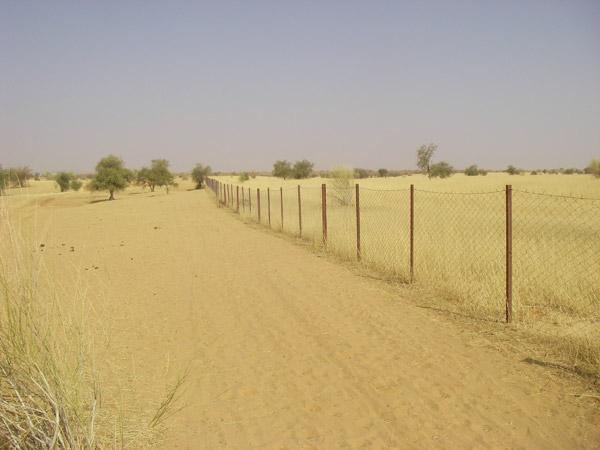 Fencing is used to protect wildlife against poaching and human encroachment, and also to protect people and livestock from wildlife. As a conservation strategy, it has proponents as well as detractors. A recent paper by a team of 45 international researchers in the Journal of Applied Ecology questions the wisdom of erecting wildlife fencing in […]
Fencing is used to protect wildlife against poaching and human encroachment, and also to protect people and livestock from wildlife. As a conservation strategy, it has proponents as well as detractors. A recent paper by a team of 45 international researchers in the Journal of Applied Ecology questions the wisdom of erecting wildlife fencing in […]
Photo essay: the flying fox show
 Sunda flying fox silhouettes against the sunset. Photo by: Tiffany Roufs. Rain or clear, wind or still, full moon or no. Every night thousands of flying foxes rise from a small mangrove island among the lesser Sunda islands of Indonesia. Around sunset the Sunda flying fox (Acerodon mackloti) begin to stir in their roots—their stomachs […]
Sunda flying fox silhouettes against the sunset. Photo by: Tiffany Roufs. Rain or clear, wind or still, full moon or no. Every night thousands of flying foxes rise from a small mangrove island among the lesser Sunda islands of Indonesia. Around sunset the Sunda flying fox (Acerodon mackloti) begin to stir in their roots—their stomachs […]
Meet Biomuseo: the world’s first biodiversity museum
 An interview with George Angehr Photograph of newly built Biomuseo biodiversity museum in Panama City, Panama. Photo by: Fernando Aldo, September, 2014. Biomuseo, designed by internationally renowned architect, Frank Gehry, is the first museum in the world dedicated to biodiversity. Opened in October 2014, the museum is located at the end of the Amador Causeway […]
An interview with George Angehr Photograph of newly built Biomuseo biodiversity museum in Panama City, Panama. Photo by: Fernando Aldo, September, 2014. Biomuseo, designed by internationally renowned architect, Frank Gehry, is the first museum in the world dedicated to biodiversity. Opened in October 2014, the museum is located at the end of the Amador Causeway […]
Monarch butterfly population rises a little, but still perilously low
 Monarch butterfly population is second lowest on record The shrinking of the migrating monarch butterfly population. Image by: WWF. The world’s migrating monarch butterfly population has bounced back slightly from its record low last year, but the new numbers are still the second smallest on record. According to WWF-Mexico and the Mexican government, butterflies covered […]
Monarch butterfly population is second lowest on record The shrinking of the migrating monarch butterfly population. Image by: WWF. The world’s migrating monarch butterfly population has bounced back slightly from its record low last year, but the new numbers are still the second smallest on record. According to WWF-Mexico and the Mexican government, butterflies covered […]
Malta approves public referendum of bird hunt that kills over 15,000
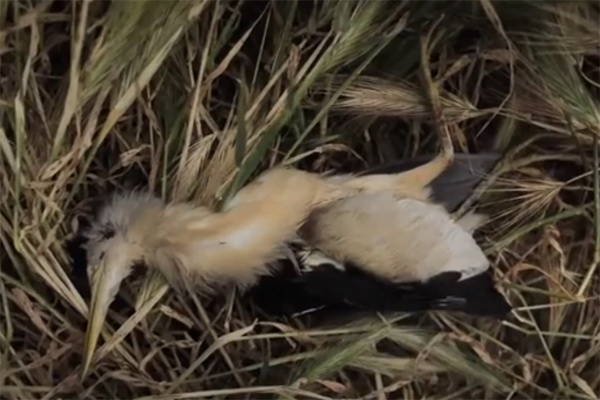 Little bittern (Ixobrychus minutus) illegally shot in Malta. Image taken from a screenshot from Malta – Massacre on Migration Episode 2. Malta’s Constitutional Court has upheld a public referendum to decide the fate of the country’s controversial spring bird hunt, which kills over ten thousand migrating birds every year. The Constitutional Court threw out objections […]
Little bittern (Ixobrychus minutus) illegally shot in Malta. Image taken from a screenshot from Malta – Massacre on Migration Episode 2. Malta’s Constitutional Court has upheld a public referendum to decide the fate of the country’s controversial spring bird hunt, which kills over ten thousand migrating birds every year. The Constitutional Court threw out objections […]
By killing off older fish, overfishing may lead to lost migratory patterns
 Catching older fish may impact a school’s ability to migrate from spawning grounds to feeding areas, according to a recent study published in the Journal of the Royal Society Interface. The study’s scientists believe that fish schools may retain a collective memory, a communal mind map of sorts, which help these groups reach their destinations, […]
Catching older fish may impact a school’s ability to migrate from spawning grounds to feeding areas, according to a recent study published in the Journal of the Royal Society Interface. The study’s scientists believe that fish schools may retain a collective memory, a communal mind map of sorts, which help these groups reach their destinations, […]
‘Canary in the cornfield’: monarch butterfly may get threatened species status
 Species declined 90 percent in 20 years Monarch butterflies were once a common sight throughout the North American heartland. In Mexico, where they overwinter, single trees would often be covered in thousands. But declines in milkweed – their caterpillars’ only source of food – have led to a 90 percent decline in monarch numbers. Now, […]
Species declined 90 percent in 20 years Monarch butterflies were once a common sight throughout the North American heartland. In Mexico, where they overwinter, single trees would often be covered in thousands. But declines in milkweed – their caterpillars’ only source of food – have led to a 90 percent decline in monarch numbers. Now, […]
Shot Egyptian vulture leads conservationists to bizarre black-market for bird parts
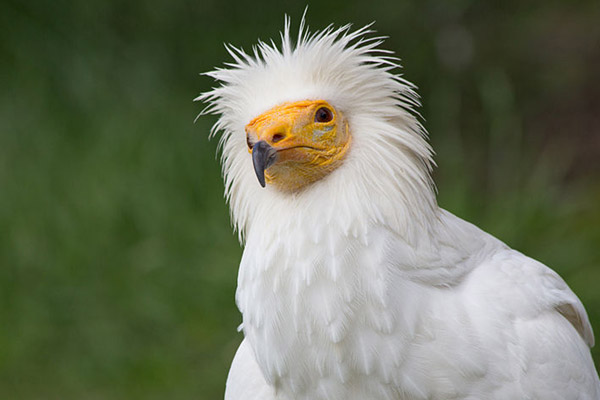 Captive Egyptian vulture adult. Photo by: Carlos Delgado/Creative Commons 3.0. The hunt Around 11 AM on Thursday, 27 February 2014, Angoulou Enika was lying hidden in the tall grass on the side of a large water hole in the Sahel region of Niger. He was staying as quiet as he could while aiming his custom-made […]
Captive Egyptian vulture adult. Photo by: Carlos Delgado/Creative Commons 3.0. The hunt Around 11 AM on Thursday, 27 February 2014, Angoulou Enika was lying hidden in the tall grass on the side of a large water hole in the Sahel region of Niger. He was staying as quiet as he could while aiming his custom-made […]
Regional court kills controversial Serengeti Highway
 Lionness with kill in Tanzania. Photo by: Rhett A. Butler. The Serengeti ecosystem got a major reprieve last week when the East African Court of Justice (EACJ) ruled against a hugely-controversial plan to build a paved road through Tanzania’s Serengeti National Park. The court dubbed the proposed road “unlawful” due to expected environmental impacts. The […]
Lionness with kill in Tanzania. Photo by: Rhett A. Butler. The Serengeti ecosystem got a major reprieve last week when the East African Court of Justice (EACJ) ruled against a hugely-controversial plan to build a paved road through Tanzania’s Serengeti National Park. The court dubbed the proposed road “unlawful” due to expected environmental impacts. The […]
Zebras for the win! Africa’s longest land migration discovered
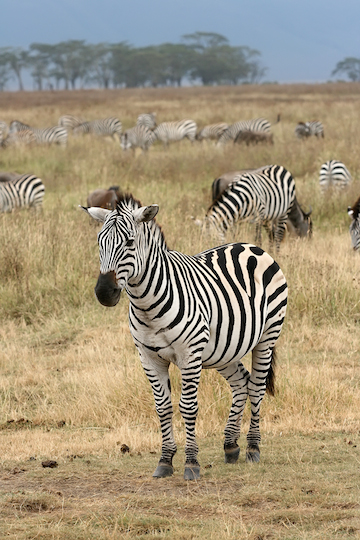 With food and water scarce in many parts of Africa, many species migrate long-distances in order to survive. A new study published in the journal, Oryx has found a new record-breaker for the continent’s longest tracked terrestrial migration: a huge group of zebras that traveled a total distance of 500 kilometers (300 miles). The journey […]
With food and water scarce in many parts of Africa, many species migrate long-distances in order to survive. A new study published in the journal, Oryx has found a new record-breaker for the continent’s longest tracked terrestrial migration: a huge group of zebras that traveled a total distance of 500 kilometers (300 miles). The journey […]
Elephants in the midst: warning system prevents human-elephant conflicts in India, saves lives
 “Elephants are headed our way,” said the text. “Please let others know.” Ganesh Raghunathan received this message, one of eight SMS messages that day from villagers across the Valparai plateau in southern India. As he does each day, Ganesh added the update to his map of the locations of elephant herds that are monitored daily, […]
“Elephants are headed our way,” said the text. “Please let others know.” Ganesh Raghunathan received this message, one of eight SMS messages that day from villagers across the Valparai plateau in southern India. As he does each day, Ganesh added the update to his map of the locations of elephant herds that are monitored daily, […]
Migrating monarch butterflies hit shockingly low numbers
 The monarch butterfly population overwintering in Mexico this year has hit its lowest numbers ever, according to WWF-Mexico. Monarch butterflies covered just 0.67 hectares in Mexico’s forest, a drop of 44 percent from 2012 already perilously low population. To put this in perspective the average monarch coverage from 1994-2014 was 6.39 or nearly ten times […]
The monarch butterfly population overwintering in Mexico this year has hit its lowest numbers ever, according to WWF-Mexico. Monarch butterflies covered just 0.67 hectares in Mexico’s forest, a drop of 44 percent from 2012 already perilously low population. To put this in perspective the average monarch coverage from 1994-2014 was 6.39 or nearly ten times […]
Reversing local extinction: scientists bring the northern bald ibis back to Europe after 300 years
 The unmistakable northern bald ibis (Geronticus eremita). Photo by: Waldrappteam. The northern bald ibis (Geronticus eremita), also called the hermit ibis or waldrapp, is a migratory bird. Once, the bald ibis lived in the Middle East, northern Africa and southern and central Europe, but due to hunting, loss of habitat and pesticide-use, the birds disappeared […]
The unmistakable northern bald ibis (Geronticus eremita). Photo by: Waldrappteam. The northern bald ibis (Geronticus eremita), also called the hermit ibis or waldrapp, is a migratory bird. Once, the bald ibis lived in the Middle East, northern Africa and southern and central Europe, but due to hunting, loss of habitat and pesticide-use, the birds disappeared […]
Scientists discover that threatened bird migrates entirely within Amazon Basin
 When one thinks of bird migrations, it’s usually a north-south route that follows seasonal climates. But researchers in the Amazon have tracked, for the first time, a largely-unknown long-distance migration that sticks entirely to the Amazon Basin. Using satellite telemetry, scientists tracked a pair of Orinoco geese (Neochen jubata) from Peru and a male from […]
When one thinks of bird migrations, it’s usually a north-south route that follows seasonal climates. But researchers in the Amazon have tracked, for the first time, a largely-unknown long-distance migration that sticks entirely to the Amazon Basin. Using satellite telemetry, scientists tracked a pair of Orinoco geese (Neochen jubata) from Peru and a male from […]
Madagascar occupied by humans 2,500 years earlier than previously thought
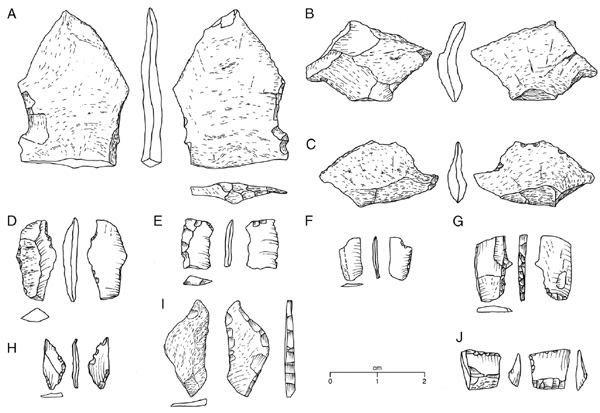 Madagascar’s first people may not have driven the island’s largest animals to extinction, suggests new study. New research indicates that Madagascar was occupied some 2,500 years earlier than previously established. The findings, published in Proceedings of the National Academy of Sciences, suggests a more complex view of the human role in the extinction of the […]
Madagascar’s first people may not have driven the island’s largest animals to extinction, suggests new study. New research indicates that Madagascar was occupied some 2,500 years earlier than previously established. The findings, published in Proceedings of the National Academy of Sciences, suggests a more complex view of the human role in the extinction of the […]
Seabirds face big problems as sea levels rise
 Migratory shorebird populations are at great risk from rising sea levels due to global climate change, warns a recent paper in Proceedings of the Royal Society B. These birds play an important role in the distribution of nutrients within wetland and coastal ecosystems, and their loss could have unknown consequences for the rest of the […]
Migratory shorebird populations are at great risk from rising sea levels due to global climate change, warns a recent paper in Proceedings of the Royal Society B. These birds play an important role in the distribution of nutrients within wetland and coastal ecosystems, and their loss could have unknown consequences for the rest of the […]
Syrian bald ibis may be down to a single bird
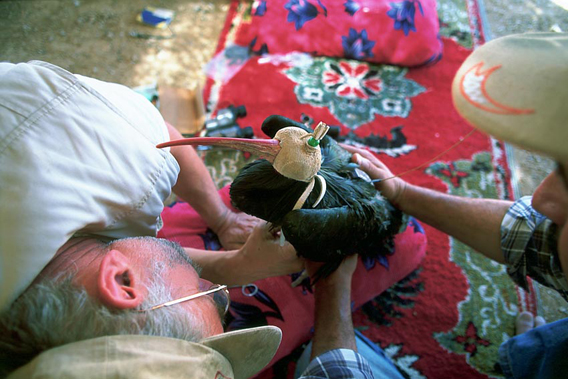 The eastern population of northern bald ibises (Geronticus eremita) has likely fallen to a single breeding bird, reports conservationists monitoring the dwindling flock. The population had believed to be obliterated starting from 1989 until a small group was discovered in 2002 in Syria. However, it now appears that this last group is vanishing one-by-one despite […]
The eastern population of northern bald ibises (Geronticus eremita) has likely fallen to a single breeding bird, reports conservationists monitoring the dwindling flock. The population had believed to be obliterated starting from 1989 until a small group was discovered in 2002 in Syria. However, it now appears that this last group is vanishing one-by-one despite […]
Compromise on Serengeti road?: build an elevated highway
 Famed anthropologist and conservationist Richard Leakey has proposed a possible solution to the hugely controversial Serengeti road: build an elevated highway. Leakey made the remarks during a conference at Rutgers University on May 14th, as reported by Live Science. The Tanzanian government’s plans to build a road through the remote, northern Serengeti has come under […]
Famed anthropologist and conservationist Richard Leakey has proposed a possible solution to the hugely controversial Serengeti road: build an elevated highway. Leakey made the remarks during a conference at Rutgers University on May 14th, as reported by Live Science. The Tanzanian government’s plans to build a road through the remote, northern Serengeti has come under […]
Famed bird reappears after 400,000 miles of flight
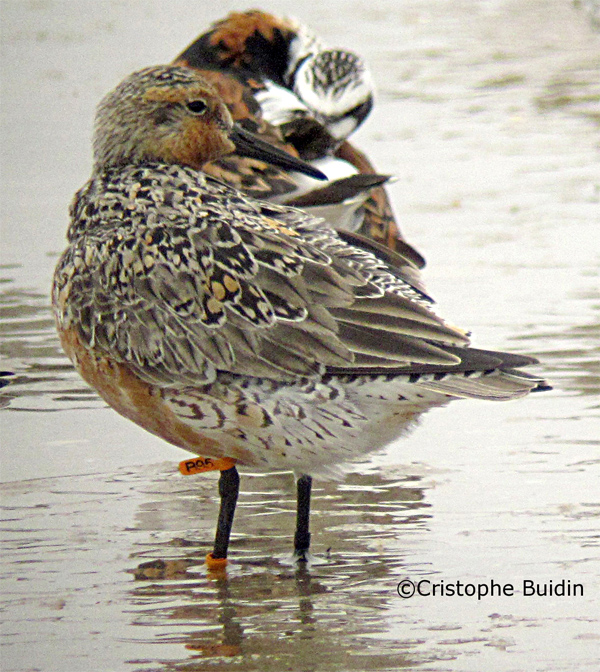 A migratory shorebird that has flown more than 400,000 miles has reappeared once again. The bird, dubbed “B95” after the number on his leg band or “Moonbird” for the distance he has flown over his lifespan, is a rufus red knot (Calidris canutus rufus) that scientists have been tracking for 19 years. Each May his […]
A migratory shorebird that has flown more than 400,000 miles has reappeared once again. The bird, dubbed “B95” after the number on his leg band or “Moonbird” for the distance he has flown over his lifespan, is a rufus red knot (Calidris canutus rufus) that scientists have been tracking for 19 years. Each May his […]
Climate change to halve habitat for over 10,000 common species
 Even as concentrations of carbon dioxide in the atmosphere hit 400 parts per million (ppm) for the first time in human history last week, a new study in Nature Climate Change warns that thousands of the world’s common species will suffer grave habitat loss under climate change. “While there has been much research on the […]
Even as concentrations of carbon dioxide in the atmosphere hit 400 parts per million (ppm) for the first time in human history last week, a new study in Nature Climate Change warns that thousands of the world’s common species will suffer grave habitat loss under climate change. “While there has been much research on the […]
Will Amazon species lose the climate change race?
 Insect nymph in Manu National Park, Peru. Photo by: Rhett A. Butler. Deforestation could increase the risk of biodiversity loss in the Amazon by forcing species to migrate further in order to remain at equilibrium with changing climates, says new research. “As migration models are made more realistic through the inclusion of multiple climatic, biotic, […]
Insect nymph in Manu National Park, Peru. Photo by: Rhett A. Butler. Deforestation could increase the risk of biodiversity loss in the Amazon by forcing species to migrate further in order to remain at equilibrium with changing climates, says new research. “As migration models are made more realistic through the inclusion of multiple climatic, biotic, […]
Bird uses hurricane winds to accelerate flight speed to 100 MPH
 Migrating Whimbrels — a type of shorebird — may struggle for hours against winds when trying to cross the Caribbean during hurricane season but get a huge boost as they fly out of storms, report researchers from the Center for Conservation Biology in Williamsburg, Virginia. Ahead of a large tropical storm last year scientists attached […]
Migrating Whimbrels — a type of shorebird — may struggle for hours against winds when trying to cross the Caribbean during hurricane season but get a huge boost as they fly out of storms, report researchers from the Center for Conservation Biology in Williamsburg, Virginia. Ahead of a large tropical storm last year scientists attached […]
B95, the great survivor
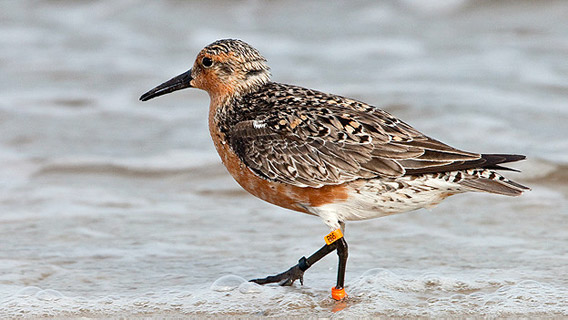 B95, the remarkable rufus red knot who has flown from the Earth to the moon in terms of distance. Photo by: Jan Van de Kam. He is so long-lived that he has surpassed all expectations, touching hearts throughout the American continent, bringing together scientists and schools, inspiring a play and now even his own biography. […]
B95, the remarkable rufus red knot who has flown from the Earth to the moon in terms of distance. Photo by: Jan Van de Kam. He is so long-lived that he has surpassed all expectations, touching hearts throughout the American continent, bringing together scientists and schools, inspiring a play and now even his own biography. […]
Turkey’s rich biodiversity at risk
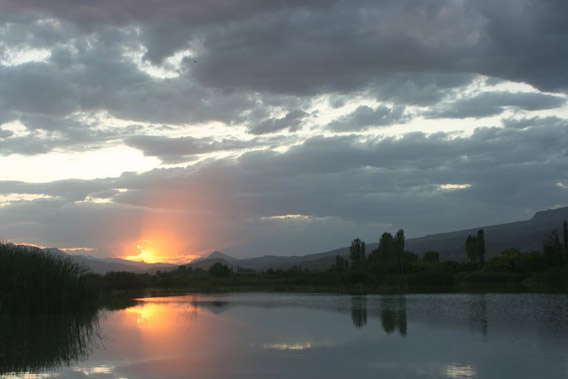 Turkey’s stunning landscapes and wildlife are under threat due to government ambivalence. Here, the sun sets outside Igdir, Turkey. Photo by: Cagan Sekercioglu. Turkey: the splendor of the Hagia Sophia, the ruins of Ephesus, and the bizarre caves of the Cappadocia. For foreign travelers, Turkey is a nation of cultural, religious, and historic wonders: a […]
Turkey’s stunning landscapes and wildlife are under threat due to government ambivalence. Here, the sun sets outside Igdir, Turkey. Photo by: Cagan Sekercioglu. Turkey: the splendor of the Hagia Sophia, the ruins of Ephesus, and the bizarre caves of the Cappadocia. For foreign travelers, Turkey is a nation of cultural, religious, and historic wonders: a […]
Madagascar originally colonized by small group of Indonesians
 Madagascar was first colonized by a small group of Indonesians who crossed the Indian Ocean some 1,200 years ago, reports a new study published in the journal Proceedings of the Royal Society B. The research, which adds to the body of evidence showing that Indonesians — not Africans — first colonized Madagascar, is based on […]
Madagascar was first colonized by a small group of Indonesians who crossed the Indian Ocean some 1,200 years ago, reports a new study published in the journal Proceedings of the Royal Society B. The research, which adds to the body of evidence showing that Indonesians — not Africans — first colonized Madagascar, is based on […]
Legal case against Serengeti road moves forward
 Female lion with wildebeest kill in Tanzania. A decline in the wildebeest population would impact species up and down the food chain. Photo by: Rhett A. Butler. A regional case against the construction of a proposed road through Serengeti National Park has moved to trial after a judge with the East African Court of Justice […]
Female lion with wildebeest kill in Tanzania. A decline in the wildebeest population would impact species up and down the food chain. Photo by: Rhett A. Butler. A regional case against the construction of a proposed road through Serengeti National Park has moved to trial after a judge with the East African Court of Justice […]
Seals, birds, and alpine plants suffer under climate change
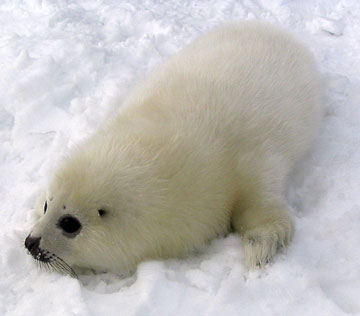 The number of species identified by scientists as vulnerable to climate change continues to rise along with the Earth’s temperature. Recent studies have found that a warmer world is leading to premature deaths of harp seal pups (Pagophilus groenlandicus) in the Arctic, a decline of some duck species in Canada, shrinking alpine meadows in Europe, […]
The number of species identified by scientists as vulnerable to climate change continues to rise along with the Earth’s temperature. Recent studies have found that a warmer world is leading to premature deaths of harp seal pups (Pagophilus groenlandicus) in the Arctic, a decline of some duck species in Canada, shrinking alpine meadows in Europe, […]
Animal picture of the day: pronghorn in the snow
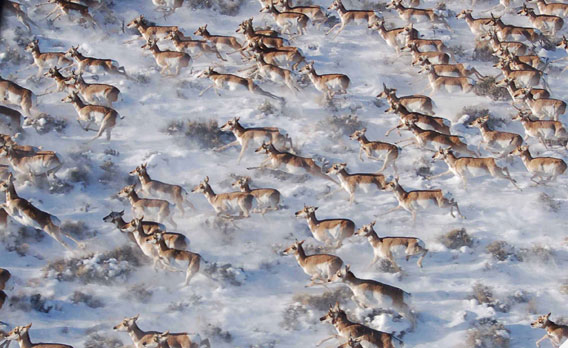 Pronghorn take off amidst the snow. Photo by: Joel Berger. Click to enlarge. Pronghorn (Antilocapra americana) are the only surviving animal in the Antilocapridae family, and contrary to popular belief they are not antelopes. Their closes living relatives are, in fact, giraffe. But, according to a new report from the Wildlife Conservation Society (WCS), the […]
Pronghorn take off amidst the snow. Photo by: Joel Berger. Click to enlarge. Pronghorn (Antilocapra americana) are the only surviving animal in the Antilocapridae family, and contrary to popular belief they are not antelopes. Their closes living relatives are, in fact, giraffe. But, according to a new report from the Wildlife Conservation Society (WCS), the […]
Top 10 Environmental Stories of 2011
 Victories won by activists around the world tops our list of the big environmental stories of the year. In this photo: a young woman is placed in handcuffs and arrested for civil disobedience against the Keystone XL Pipeline in the U.S. In all, 1,252 people were arrested in the two week long action. Photo by: […]
Victories won by activists around the world tops our list of the big environmental stories of the year. In this photo: a young woman is placed in handcuffs and arrested for civil disobedience against the Keystone XL Pipeline in the U.S. In all, 1,252 people were arrested in the two week long action. Photo by: […]
Monarch butterflies decline at wintering grounds in Mexico, Texas drought adds to stress to migration
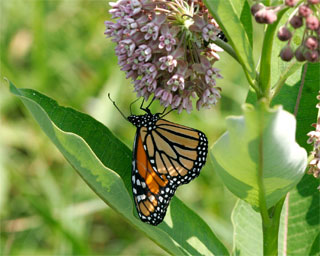 Every fall, millions of monarch butterflies travel south to Mexico and take refuge in twelve mountain sanctuaries of oyamel fir forests. Now, declining numbers of the overwintering butterflies expose the migration’s vulnerability and raise questions about threats throughout the monarch’s lifecycle. A study published online last spring in Insect Conservation and Diversity shows a decrease […]
Every fall, millions of monarch butterflies travel south to Mexico and take refuge in twelve mountain sanctuaries of oyamel fir forests. Now, declining numbers of the overwintering butterflies expose the migration’s vulnerability and raise questions about threats throughout the monarch’s lifecycle. A study published online last spring in Insect Conservation and Diversity shows a decrease […]
South Sudan’s choice: resource curse or wild wonder?
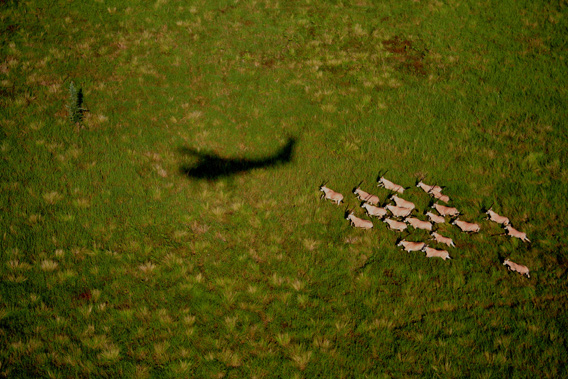 This commentary was originally published in February, but given that South Sudan has just celebrated independence over the weekend, we thought it apt to re-publish. Oryx and WCS Cessna shadow, Boma National Park. Photo by Paul Elkan and J. Michael Fay. ©2007 National Geographic/ Wildlife Conservation Society. After the people of South Sudan have voted […]
This commentary was originally published in February, but given that South Sudan has just celebrated independence over the weekend, we thought it apt to re-publish. Oryx and WCS Cessna shadow, Boma National Park. Photo by Paul Elkan and J. Michael Fay. ©2007 National Geographic/ Wildlife Conservation Society. After the people of South Sudan have voted […]
Newest country boasts one of the world’s greatest wildlife spectacles, but protection needed
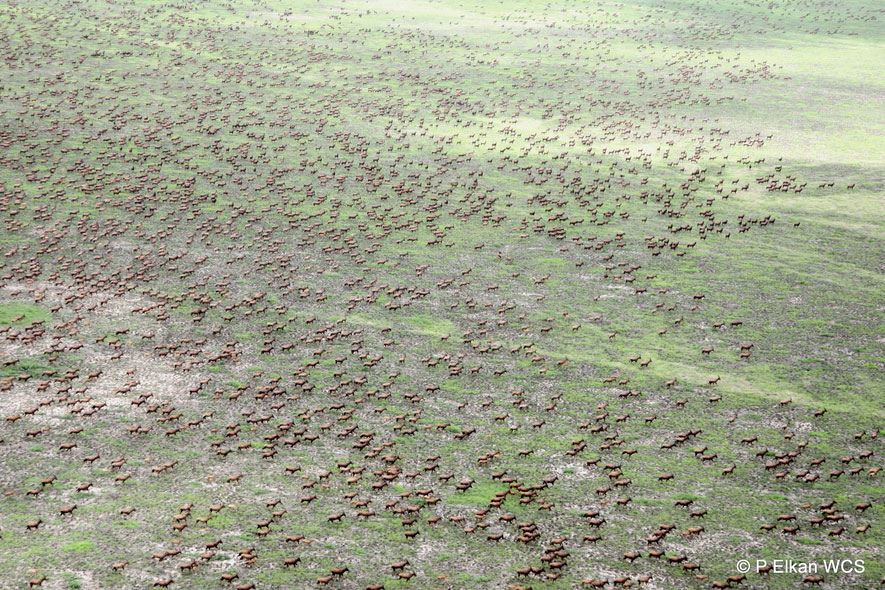 Tiang migration across Boma-Jonglei-Equatoria Landscape, South Sudan. Photo credit: © Paul Elkan/Wildlife Conservation Society. At midnight local time on Friday, South Sudan became the world’s newest nation. As celebrations continue in the new capital of Juba and congratulations come from every corner of the globe, the Wildlife Conservation Society (WCS) is urging the newborn nation […]
Tiang migration across Boma-Jonglei-Equatoria Landscape, South Sudan. Photo credit: © Paul Elkan/Wildlife Conservation Society. At midnight local time on Friday, South Sudan became the world’s newest nation. As celebrations continue in the new capital of Juba and congratulations come from every corner of the globe, the Wildlife Conservation Society (WCS) is urging the newborn nation […]
Richard Leakey: ‘selfish’ critics choose wrong fight in Serengeti road
 To read more about Tanzania’s recent announcement related to the Serengeti road: Unpaved road through Serengeti to progress. The controversial Serengeti road is going ahead, but with conditions. According to the Tanzanian Minister for Natural Resources and Tourism, Ezekiel Maige, the road will not be paved and it will be run by the Tanzanian park […]
To read more about Tanzania’s recent announcement related to the Serengeti road: Unpaved road through Serengeti to progress. The controversial Serengeti road is going ahead, but with conditions. According to the Tanzanian Minister for Natural Resources and Tourism, Ezekiel Maige, the road will not be paved and it will be run by the Tanzanian park […]
Unpaved road through Serengeti to progress
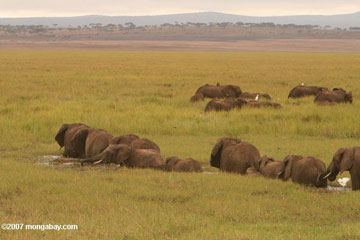 To read more about Tanzania’s recent announcement related to the Serengeti road: Richard Leakey: ‘selfish’ critics choose wrong fight in Serengeti road. After a week of confusion, the Tanzanian government has finally clarified its position on the hugely-controversial Serengeti road. The Minister for Natural Resources and Tourism, Ezekiel Maige, confirmed that a paved highway will […]
To read more about Tanzania’s recent announcement related to the Serengeti road: Richard Leakey: ‘selfish’ critics choose wrong fight in Serengeti road. After a week of confusion, the Tanzanian government has finally clarified its position on the hugely-controversial Serengeti road. The Minister for Natural Resources and Tourism, Ezekiel Maige, confirmed that a paved highway will […]
Last search for the Eskimo curlew
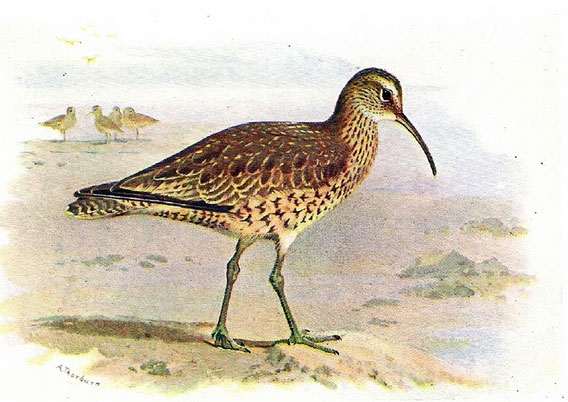 The Eskimo curlew painted by Archibald Thorburn. The Eskimo curlew is (or perhaps, ‘was’) a small migratory shorebird with a long curved beak, perfect for searching shorelines and prairie grass for worms, grasshoppers and other insects, as well as goodies including berries. Described as cinnamon-colored, the bird nested in the Arctic tundra of Alaska and […]
The Eskimo curlew painted by Archibald Thorburn. The Eskimo curlew is (or perhaps, ‘was’) a small migratory shorebird with a long curved beak, perfect for searching shorelines and prairie grass for worms, grasshoppers and other insects, as well as goodies including berries. Described as cinnamon-colored, the bird nested in the Arctic tundra of Alaska and […]
Serengeti road cancelled
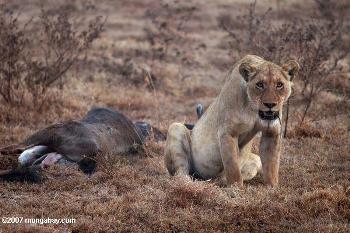 UPDATE: Tanzania has announced it will be going ahead with a gravel road through the Serengeti. For more information: Unpaved road through Serengeti to progress and Richard Leakey: ‘selfish’ critics choose wrong fight in Serengeti road. In what is a victory for environmentalists, scientists, tourism, and the largest land migration on Earth, the Tanzanian government […]
UPDATE: Tanzania has announced it will be going ahead with a gravel road through the Serengeti. For more information: Unpaved road through Serengeti to progress and Richard Leakey: ‘selfish’ critics choose wrong fight in Serengeti road. In what is a victory for environmentalists, scientists, tourism, and the largest land migration on Earth, the Tanzanian government […]
New eco-tour to help save bizarre antelope in ‘forgotten’ region
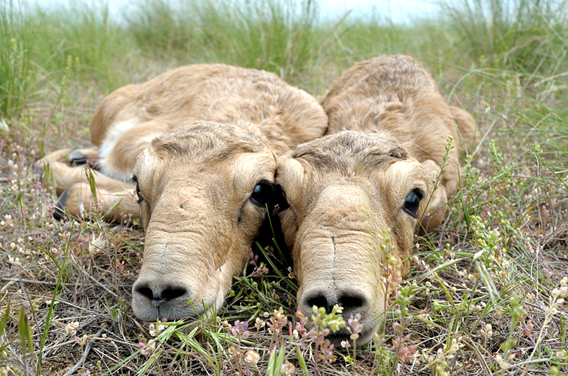 Saiga calves. Photo by: Igor Shpilenok. Imagine visiting a region that is largely void of tourists, yet has world-class bird watching, a unique Buddhist population, and one of the world’s most bizarre-looking and imperilled mammals: the saiga. A new tour to Southern Russia hopes to aid a Critically Endangered species while giving tourists an inside […]
Saiga calves. Photo by: Igor Shpilenok. Imagine visiting a region that is largely void of tourists, yet has world-class bird watching, a unique Buddhist population, and one of the world’s most bizarre-looking and imperilled mammals: the saiga. A new tour to Southern Russia hopes to aid a Critically Endangered species while giving tourists an inside […]
From the Serengeti to Lake Natron: is the Tanzanian government aiming to destroy its wildlife and lands?
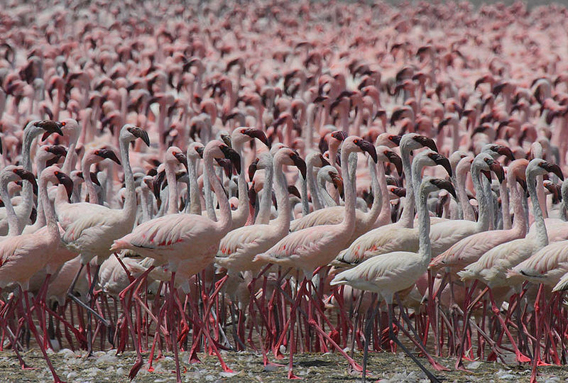 Thousands of lesser flamingoes (Phoenicopterus minor) crowd in Lake Bogoria in Kenya. Nearly all of these flamingoes will breed in Tanzania’s Lake Natron, now a proposed site for soda ash mining. Photo by: Steve Garvie. What’s happening in Tanzania? This is a question making the rounds in conservation and environmental circles. Why is a nation […]
Thousands of lesser flamingoes (Phoenicopterus minor) crowd in Lake Bogoria in Kenya. Nearly all of these flamingoes will breed in Tanzania’s Lake Natron, now a proposed site for soda ash mining. Photo by: Steve Garvie. What’s happening in Tanzania? This is a question making the rounds in conservation and environmental circles. Why is a nation […]
Serengeti road project opposed by ‘powerful’ tour company lobby
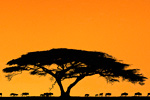 Government plans to build a road through Serengeti National Park came up against more opposition this week as the Tanzanian Association of Tour Operators (Tato) came out against the project, reports The Citizen. Tato, described as powerful local lobby group by the Tanzanian media, stated that the road would hurt tourism and urged the government […]
Government plans to build a road through Serengeti National Park came up against more opposition this week as the Tanzanian Association of Tour Operators (Tato) came out against the project, reports The Citizen. Tato, described as powerful local lobby group by the Tanzanian media, stated that the road would hurt tourism and urged the government […]
Foreign big agriculture threatens world’s second largest wildlife migration
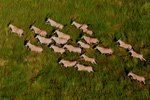 As the world’s largest migration in the Serengeti plains—including two million wildebeest, zebra, and Thomson’s gazelles—has come under unprecedented threat due to plans for a road that would sever the migration route, a far lesser famous, but nearly as large migration, is being silently eroded just 1,370 miles (2,200 kilometers) north in Ethiopia’s Gambela National […]
As the world’s largest migration in the Serengeti plains—including two million wildebeest, zebra, and Thomson’s gazelles—has come under unprecedented threat due to plans for a road that would sever the migration route, a far lesser famous, but nearly as large migration, is being silently eroded just 1,370 miles (2,200 kilometers) north in Ethiopia’s Gambela National […]
First International Serengeti Day hopes to halt road project
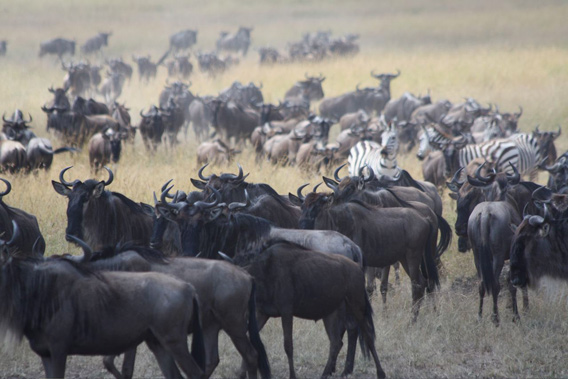 Migrating wildebeest and zebra. Photo by: Jan Martin McGuire. On March 19th the conservation organization, Serengeti Watch, is planning the world’s first International Serengeti Day to celebrate one of the world’s most treasured wildlife ecosystems. But the day also has another goal: bring attention to a Tanzanian government plan to build a road that would […]
Migrating wildebeest and zebra. Photo by: Jan Martin McGuire. On March 19th the conservation organization, Serengeti Watch, is planning the world’s first International Serengeti Day to celebrate one of the world’s most treasured wildlife ecosystems. But the day also has another goal: bring attention to a Tanzanian government plan to build a road that would […]
As South Sudan eyes independence, will it choose choose to protect its wildlife?
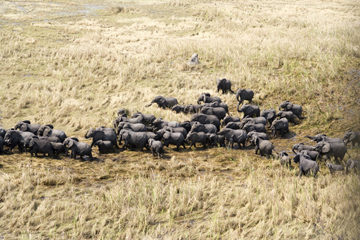 After the people of South Sudan have voted overwhelmingly for independence, the work of building a nation begins. Set to become the world’s newest country on July 9th of this year, one of many tasks facing the nation’s nascent leaders is the conservation of its stunning wildlife. In 2007, following two decades of brutal civil […]
After the people of South Sudan have voted overwhelmingly for independence, the work of building a nation begins. Set to become the world’s newest country on July 9th of this year, one of many tasks facing the nation’s nascent leaders is the conservation of its stunning wildlife. In 2007, following two decades of brutal civil […]
Scientists: road through Serengeti would likely end wildebeest migration
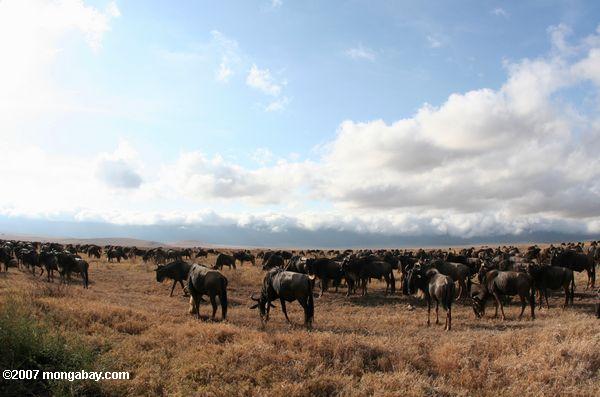 A new study finds that a proposed road cutting through Serengeti National Park would likely have devastating consequences for one of the world’s last great migrations. According to the study the road itself could lead to a 35% loss in the famed park’s migrating wildebeest herd, essentially cutting the herd down by over half a […]
A new study finds that a proposed road cutting through Serengeti National Park would likely have devastating consequences for one of the world’s last great migrations. According to the study the road itself could lead to a 35% loss in the famed park’s migrating wildebeest herd, essentially cutting the herd down by over half a […]
World Bank offers to save Serengeti from bisecting road
 The World Bank has offered to help fund an alternative route for a planned road project that would otherwise cut through Tanzania’s world famous Serengeti National Park, according to the German-based NGO Nature and Biodiversity Conservation Union (NABU). When announced last year, the road project raised protests from environmentalists, scientists, and Tanzanian tour companies, but […]
The World Bank has offered to help fund an alternative route for a planned road project that would otherwise cut through Tanzania’s world famous Serengeti National Park, according to the German-based NGO Nature and Biodiversity Conservation Union (NABU). When announced last year, the road project raised protests from environmentalists, scientists, and Tanzanian tour companies, but […]
Lack of schools, trade drive exodus from remote parts of the Amazon
 Lack of school access and higher costs of trade are driving an exodus from remote areas in the Amazon, a new study published in Population & Environment reveals. The research sheds light on to why people are leaving remote forest areas. It follows an earlier publication indicating that migration away from remote rural areas may […]
Lack of school access and higher costs of trade are driving an exodus from remote areas in the Amazon, a new study published in Population & Environment reveals. The research sheds light on to why people are leaving remote forest areas. It follows an earlier publication indicating that migration away from remote rural areas may […]
Earth could see 4 degrees Celsius warming in less than a lifetime
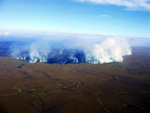 By the time children born this year reach 50 years old, the Earth could be 4 degrees Celsius warmer (7.2 degrees Fahrenheit) warns a new study as governments meet in Cancun for this year’s UN climate summit, which is not expected to produce an agreement. Last year governments pledged in the non-binding Copenhagen Accord to […]
By the time children born this year reach 50 years old, the Earth could be 4 degrees Celsius warmer (7.2 degrees Fahrenheit) warns a new study as governments meet in Cancun for this year’s UN climate summit, which is not expected to produce an agreement. Last year governments pledged in the non-binding Copenhagen Accord to […]
Flight of the Monarchs Reveals Environmental Connections across a Continent
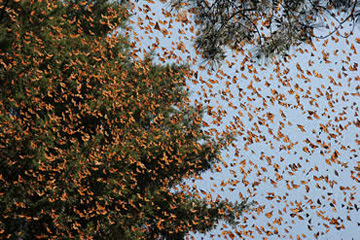 As autumn settles across North America, one hallmark of the season is the gentle southward flight of the Monarch Butterflies as they migrate towards the forests that shelter their species during the winter months. Unfortunately, as with other forests across the planet, the Monarch’s “over- wintering grounds” in Mexico are suffering from increased human pressures. […]
As autumn settles across North America, one hallmark of the season is the gentle southward flight of the Monarch Butterflies as they migrate towards the forests that shelter their species during the winter months. Unfortunately, as with other forests across the planet, the Monarch’s “over- wintering grounds” in Mexico are suffering from increased human pressures. […]
Flickr reveals longest whale migration
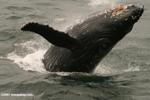 Communal photo sharing site, Flickr, has allowed researchers to discover the longest migration by a whale yet recorded. Ten years ago a female humpback whale swam from Brazil to Madagascar, covering around 6,090 miles (9,800 kilometers). The migration tops the previous record by 2,485 miles (4,000 kilometers). Not only is this a record for a […]
Communal photo sharing site, Flickr, has allowed researchers to discover the longest migration by a whale yet recorded. Ten years ago a female humpback whale swam from Brazil to Madagascar, covering around 6,090 miles (9,800 kilometers). The migration tops the previous record by 2,485 miles (4,000 kilometers). Not only is this a record for a […]
The true cost of the Commonwealth Games
 UK newspapers have been flooded this week and last by reports of the Commonwealth Games’ venue literally caving in and collapsing, athletes have deemed their village accommodation “filthy” and terrorists have apparently threatened attacks. Thanks to the late monsoon this year, floods are now a fear, and the Games’ venue has been choked by a […]
UK newspapers have been flooded this week and last by reports of the Commonwealth Games’ venue literally caving in and collapsing, athletes have deemed their village accommodation “filthy” and terrorists have apparently threatened attacks. Thanks to the late monsoon this year, floods are now a fear, and the Games’ venue has been choked by a […]
Road through the Serengeti will eventually ‘kill the migration’
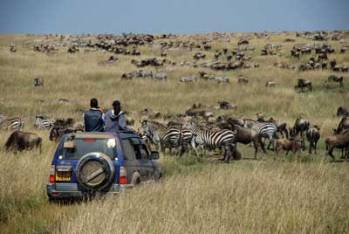 Tourists, conservationists, individuals, and tour companies have launched an international outcry against the Tanzanian authorities in response to the announcement of the planned construction of the trans-Serengeti Highway highway. There is even a Facebook group and an online petition with 5,038 signatures. But the government has responded by saying that the plans are still on […]
Tourists, conservationists, individuals, and tour companies have launched an international outcry against the Tanzanian authorities in response to the announcement of the planned construction of the trans-Serengeti Highway highway. There is even a Facebook group and an online petition with 5,038 signatures. But the government has responded by saying that the plans are still on […]
Gulf oil spill could impact non-coastal songbirds
Even though they don’t stop over in the Gulf of Mexico, many migrating songbirds could be impacted by the catastrophic oil spill in the area, warns the American Bird Conservancy (ABC). The threats to marine and coastal birds have been well-outlined during the past few days, however birds flying high above the spill could also […]
Galapagos fur seals exploit warmer waters to establish colony off Peru
As suggested by their name, the Galapagos fur seals were once endemic to the Galapagos island chain off the coast of Ecuador. But in a warming world species are on the move, and the Galapagos fur seal is no exception. According to a recent story in Reuters the Galapagos fur seals have established what appears […]
Sophisticated flying methods allow insects to hitchhike on fast winds
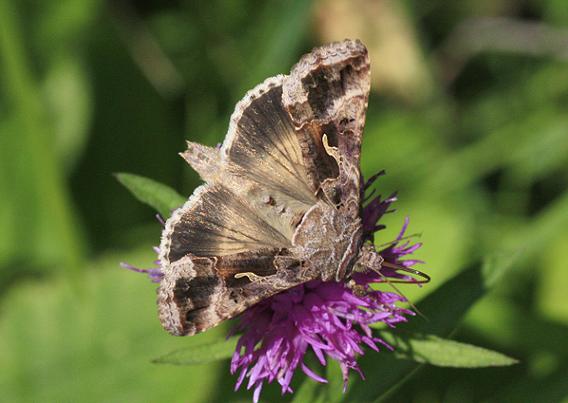 Researchers have long been fascinated by how insects migrate thousands of kilometers, for example from Britain to the Mediterranean. A new study, published in Science shows that although tiny, insects are not at the mercy of winds as expected. Instead they employ sophisticated flight behaviors to use fast winds to their advantage. Employing specially-designed radar, […]
Researchers have long been fascinated by how insects migrate thousands of kilometers, for example from Britain to the Mediterranean. A new study, published in Science shows that although tiny, insects are not at the mercy of winds as expected. Instead they employ sophisticated flight behaviors to use fast winds to their advantage. Employing specially-designed radar, […]
Conservation organization purchases vital wildlife corridor for elephants in India
 On Christmas Eve, the Wildlife Trust of India (WTI) and the International Fund for Animal Welfare (IFAW) completed a transaction to purchase an important wildlie corridor used by over a thousand Asian elephants (Elephas maximus). The 25.4 acre Kollegal Elephant Corridor was under private ownership, but may now be incorporated into adjacent Biligiri Ranganswamy Temple […]
On Christmas Eve, the Wildlife Trust of India (WTI) and the International Fund for Animal Welfare (IFAW) completed a transaction to purchase an important wildlie corridor used by over a thousand Asian elephants (Elephas maximus). The 25.4 acre Kollegal Elephant Corridor was under private ownership, but may now be incorporated into adjacent Biligiri Ranganswamy Temple […]
Housing developments choking wildlife around America’s national parks
 Americans are ‘loving [their] protected areas to death’. Housing developments within 50 kilometers (31 miles) of America’s national parks have nearly quadrupled in sixty years, rising from 9.8 million housing units to 38 million from 1940 to 2000. The explosion of housing developments adjacent to national parks threatens wildlife in a variety of ways, according […]
Americans are ‘loving [their] protected areas to death’. Housing developments within 50 kilometers (31 miles) of America’s national parks have nearly quadrupled in sixty years, rising from 9.8 million housing units to 38 million from 1940 to 2000. The explosion of housing developments adjacent to national parks threatens wildlife in a variety of ways, according […]
A ‘dangerous world’ for migratory birds, an interview with Sarah Lehnen
 A recent PhD graduate of Ohio State University, Sarah Lehnen studies America’s birds with a particular focus on migrating shorebirds. Mongabay.com’s seventh in a series of interviews with ‘Young Scientists’. Sarah Lehnen has worked with America’s rich birdlife for a decade: she has studied everything from songbirds inhabiting dwindling shrub land in Ohio to shorebirds […]
A recent PhD graduate of Ohio State University, Sarah Lehnen studies America’s birds with a particular focus on migrating shorebirds. Mongabay.com’s seventh in a series of interviews with ‘Young Scientists’. Sarah Lehnen has worked with America’s rich birdlife for a decade: she has studied everything from songbirds inhabiting dwindling shrub land in Ohio to shorebirds […]
Did fish poisoning drive Polynesian colonization of the Pacific?
 The reasons behind the colonization of the Pacific islands have long been sources of controversy and fascination. Now a new study looks into toxic fish poisoning as a possible migration catalyst. Between AD 1000 and 1450, Polynesian colonization of the South Pacific flourished. The voyages that were undertaken in the discovery of these new lands […]
The reasons behind the colonization of the Pacific islands have long been sources of controversy and fascination. Now a new study looks into toxic fish poisoning as a possible migration catalyst. Between AD 1000 and 1450, Polynesian colonization of the South Pacific flourished. The voyages that were undertaken in the discovery of these new lands […]
Migrations of large mammals in serious declines, six have vanished entirely
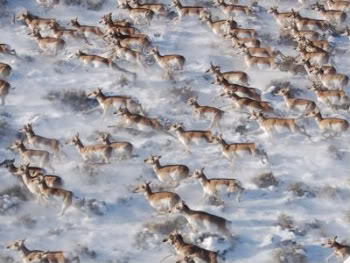 Watch any nature documentary and it’s sure to include pulse-pounding footage of large herbivores migrating across African plains, Asian steppe, or the Arctic tundra. The images have become iconic: wildebeest forging a crocodile-inhabited river, caribou breaking through snow fields, Saiga running over tall grass. Despite such images of plenty, migrations are declining across the world, […]
Watch any nature documentary and it’s sure to include pulse-pounding footage of large herbivores migrating across African plains, Asian steppe, or the Arctic tundra. The images have become iconic: wildebeest forging a crocodile-inhabited river, caribou breaking through snow fields, Saiga running over tall grass. Despite such images of plenty, migrations are declining across the world, […]
Bird migrations lengthen due to global warming, threatening species
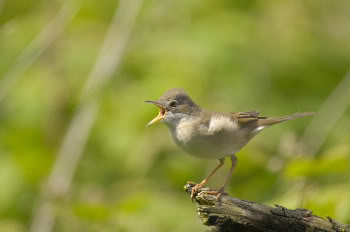 Global warming is likely to increase the length of bird migrations, some of which already extend thousands of miles. The increased distance could imperil certain species, as it would require more energy reserves than may be available. The new study, published in the Journal of Biogeography, studied the migration patterns of European Sylvia warblers from […]
Global warming is likely to increase the length of bird migrations, some of which already extend thousands of miles. The increased distance could imperil certain species, as it would require more energy reserves than may be available. The new study, published in the Journal of Biogeography, studied the migration patterns of European Sylvia warblers from […]
Marine Protected Areas too small for whales and dolphins
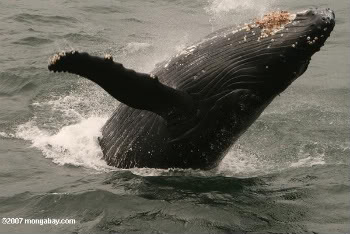 Current Marine Protected Areas (MPAs) are too small to adequately serve whales and dolphins according to the Whale and Dolphin Conservation Society (WDCS). The international organization is calling for a global network of MPAs to save the ocean’s most beloved inhabitants. “A worldwide effort must be made urgently to identify and define whale and dolphin […]
Current Marine Protected Areas (MPAs) are too small to adequately serve whales and dolphins according to the Whale and Dolphin Conservation Society (WDCS). The international organization is calling for a global network of MPAs to save the ocean’s most beloved inhabitants. “A worldwide effort must be made urgently to identify and define whale and dolphin […]
New technology allows researchers to study mass migrations of fish
 Employing a new technology, MIT engineers have studied the origins of a mass gathering of hundreds of millions of fish and their subsequent migration. This is the first time a mass migration of animals has been studied from beginning to end, according to their paper published in Science. Until now biologists have depended on theory […]
Employing a new technology, MIT engineers have studied the origins of a mass gathering of hundreds of millions of fish and their subsequent migration. This is the first time a mass migration of animals has been studied from beginning to end, according to their paper published in Science. Until now biologists have depended on theory […]
Can remittances and globalization help the environment?
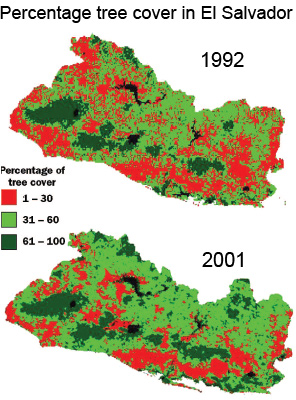 Can remittances and globalization help the environment? Can remittances and globalization help the environment? Rhett A. Butler, mongabay.com September 6, 2007 Globalization and other economic trends appear to be helping the degraded forests of El Salvador recover, reports new research that evaluated the impact of global trade, land policy changes, and remittances on forest cover. […]
Can remittances and globalization help the environment? Can remittances and globalization help the environment? Rhett A. Butler, mongabay.com September 6, 2007 Globalization and other economic trends appear to be helping the degraded forests of El Salvador recover, reports new research that evaluated the impact of global trade, land policy changes, and remittances on forest cover. […]
Climate change drove human evolution
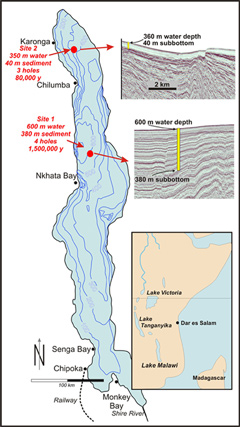 Climate change drove human evolution Climate change drove human evolution mongabay.com September 3, 2007 Climate change appears to have been a significant driver of human evolution, report researchers writing in this week’s issue of the journal Proceedings of the National Academy of Science (PNAS). Studying deep sediment cores from Lake Malawi in Africa, Syracuse University […]
Climate change drove human evolution Climate change drove human evolution mongabay.com September 3, 2007 Climate change appears to have been a significant driver of human evolution, report researchers writing in this week’s issue of the journal Proceedings of the National Academy of Science (PNAS). Studying deep sediment cores from Lake Malawi in Africa, Syracuse University […]
Floods affect 500 million people per year, will worsen with warming
Floods affect 500 million people per year, will worsen with warming Floods affect 500 million people per year, will worsen with warming mongabay.com August 10, 2007 Floods affect 500 million people a year and cause billions of dollars in damage, said U.N. officials Thursday. Sálvano Briceño, director of the UN International Strategy for Disaster Reduction, […]
Asians played larger role in colonization of Europe than Africans
Asians played larger role in colonization of Europe than Africans Asians played larger role in colonization of Europe than Africans mongabay.com August 6, 2007 Humans with Asian origins played a larger role than those from Africa in colonizing Europe millions of years ago, reports a paper published in the early online edition of the journal […]
Feeds: news | india | latam | brasil | indonesia
 Fencing is used to protect wildlife against poaching and human encroachment, and also to protect people and livestock from wildlife. As a conservation strategy, it has proponents as well as detractors. A recent paper by a team of 45 international researchers in the Journal of Applied Ecology questions the wisdom of erecting wildlife fencing in […]
Fencing is used to protect wildlife against poaching and human encroachment, and also to protect people and livestock from wildlife. As a conservation strategy, it has proponents as well as detractors. A recent paper by a team of 45 international researchers in the Journal of Applied Ecology questions the wisdom of erecting wildlife fencing in […] Sunda flying fox silhouettes against the sunset. Photo by: Tiffany Roufs. Rain or clear, wind or still, full moon or no. Every night thousands of flying foxes rise from a small mangrove island among the lesser Sunda islands of Indonesia. Around sunset the Sunda flying fox (Acerodon mackloti) begin to stir in their roots—their stomachs […]
Sunda flying fox silhouettes against the sunset. Photo by: Tiffany Roufs. Rain or clear, wind or still, full moon or no. Every night thousands of flying foxes rise from a small mangrove island among the lesser Sunda islands of Indonesia. Around sunset the Sunda flying fox (Acerodon mackloti) begin to stir in their roots—their stomachs […] An interview with George Angehr Photograph of newly built Biomuseo biodiversity museum in Panama City, Panama. Photo by: Fernando Aldo, September, 2014. Biomuseo, designed by internationally renowned architect, Frank Gehry, is the first museum in the world dedicated to biodiversity. Opened in October 2014, the museum is located at the end of the Amador Causeway […]
An interview with George Angehr Photograph of newly built Biomuseo biodiversity museum in Panama City, Panama. Photo by: Fernando Aldo, September, 2014. Biomuseo, designed by internationally renowned architect, Frank Gehry, is the first museum in the world dedicated to biodiversity. Opened in October 2014, the museum is located at the end of the Amador Causeway […] Monarch butterfly population is second lowest on record The shrinking of the migrating monarch butterfly population. Image by: WWF. The world’s migrating monarch butterfly population has bounced back slightly from its record low last year, but the new numbers are still the second smallest on record. According to WWF-Mexico and the Mexican government, butterflies covered […]
Monarch butterfly population is second lowest on record The shrinking of the migrating monarch butterfly population. Image by: WWF. The world’s migrating monarch butterfly population has bounced back slightly from its record low last year, but the new numbers are still the second smallest on record. According to WWF-Mexico and the Mexican government, butterflies covered […] Little bittern (Ixobrychus minutus) illegally shot in Malta. Image taken from a screenshot from Malta – Massacre on Migration Episode 2. Malta’s Constitutional Court has upheld a public referendum to decide the fate of the country’s controversial spring bird hunt, which kills over ten thousand migrating birds every year. The Constitutional Court threw out objections […]
Little bittern (Ixobrychus minutus) illegally shot in Malta. Image taken from a screenshot from Malta – Massacre on Migration Episode 2. Malta’s Constitutional Court has upheld a public referendum to decide the fate of the country’s controversial spring bird hunt, which kills over ten thousand migrating birds every year. The Constitutional Court threw out objections […] Catching older fish may impact a school’s ability to migrate from spawning grounds to feeding areas, according to a recent study published in the Journal of the Royal Society Interface. The study’s scientists believe that fish schools may retain a collective memory, a communal mind map of sorts, which help these groups reach their destinations, […]
Catching older fish may impact a school’s ability to migrate from spawning grounds to feeding areas, according to a recent study published in the Journal of the Royal Society Interface. The study’s scientists believe that fish schools may retain a collective memory, a communal mind map of sorts, which help these groups reach their destinations, […] Species declined 90 percent in 20 years Monarch butterflies were once a common sight throughout the North American heartland. In Mexico, where they overwinter, single trees would often be covered in thousands. But declines in milkweed – their caterpillars’ only source of food – have led to a 90 percent decline in monarch numbers. Now, […]
Species declined 90 percent in 20 years Monarch butterflies were once a common sight throughout the North American heartland. In Mexico, where they overwinter, single trees would often be covered in thousands. But declines in milkweed – their caterpillars’ only source of food – have led to a 90 percent decline in monarch numbers. Now, […] Captive Egyptian vulture adult. Photo by: Carlos Delgado/Creative Commons 3.0. The hunt Around 11 AM on Thursday, 27 February 2014, Angoulou Enika was lying hidden in the tall grass on the side of a large water hole in the Sahel region of Niger. He was staying as quiet as he could while aiming his custom-made […]
Captive Egyptian vulture adult. Photo by: Carlos Delgado/Creative Commons 3.0. The hunt Around 11 AM on Thursday, 27 February 2014, Angoulou Enika was lying hidden in the tall grass on the side of a large water hole in the Sahel region of Niger. He was staying as quiet as he could while aiming his custom-made […] Lionness with kill in Tanzania. Photo by: Rhett A. Butler. The Serengeti ecosystem got a major reprieve last week when the East African Court of Justice (EACJ) ruled against a hugely-controversial plan to build a paved road through Tanzania’s Serengeti National Park. The court dubbed the proposed road “unlawful” due to expected environmental impacts. The […]
Lionness with kill in Tanzania. Photo by: Rhett A. Butler. The Serengeti ecosystem got a major reprieve last week when the East African Court of Justice (EACJ) ruled against a hugely-controversial plan to build a paved road through Tanzania’s Serengeti National Park. The court dubbed the proposed road “unlawful” due to expected environmental impacts. The […] With food and water scarce in many parts of Africa, many species migrate long-distances in order to survive. A new study published in the journal, Oryx has found a new record-breaker for the continent’s longest tracked terrestrial migration: a huge group of zebras that traveled a total distance of 500 kilometers (300 miles). The journey […]
With food and water scarce in many parts of Africa, many species migrate long-distances in order to survive. A new study published in the journal, Oryx has found a new record-breaker for the continent’s longest tracked terrestrial migration: a huge group of zebras that traveled a total distance of 500 kilometers (300 miles). The journey […] “Elephants are headed our way,” said the text. “Please let others know.” Ganesh Raghunathan received this message, one of eight SMS messages that day from villagers across the Valparai plateau in southern India. As he does each day, Ganesh added the update to his map of the locations of elephant herds that are monitored daily, […]
“Elephants are headed our way,” said the text. “Please let others know.” Ganesh Raghunathan received this message, one of eight SMS messages that day from villagers across the Valparai plateau in southern India. As he does each day, Ganesh added the update to his map of the locations of elephant herds that are monitored daily, […] The monarch butterfly population overwintering in Mexico this year has hit its lowest numbers ever, according to WWF-Mexico. Monarch butterflies covered just 0.67 hectares in Mexico’s forest, a drop of 44 percent from 2012 already perilously low population. To put this in perspective the average monarch coverage from 1994-2014 was 6.39 or nearly ten times […]
The monarch butterfly population overwintering in Mexico this year has hit its lowest numbers ever, according to WWF-Mexico. Monarch butterflies covered just 0.67 hectares in Mexico’s forest, a drop of 44 percent from 2012 already perilously low population. To put this in perspective the average monarch coverage from 1994-2014 was 6.39 or nearly ten times […] The unmistakable northern bald ibis (Geronticus eremita). Photo by: Waldrappteam. The northern bald ibis (Geronticus eremita), also called the hermit ibis or waldrapp, is a migratory bird. Once, the bald ibis lived in the Middle East, northern Africa and southern and central Europe, but due to hunting, loss of habitat and pesticide-use, the birds disappeared […]
The unmistakable northern bald ibis (Geronticus eremita). Photo by: Waldrappteam. The northern bald ibis (Geronticus eremita), also called the hermit ibis or waldrapp, is a migratory bird. Once, the bald ibis lived in the Middle East, northern Africa and southern and central Europe, but due to hunting, loss of habitat and pesticide-use, the birds disappeared […] When one thinks of bird migrations, it’s usually a north-south route that follows seasonal climates. But researchers in the Amazon have tracked, for the first time, a largely-unknown long-distance migration that sticks entirely to the Amazon Basin. Using satellite telemetry, scientists tracked a pair of Orinoco geese (Neochen jubata) from Peru and a male from […]
When one thinks of bird migrations, it’s usually a north-south route that follows seasonal climates. But researchers in the Amazon have tracked, for the first time, a largely-unknown long-distance migration that sticks entirely to the Amazon Basin. Using satellite telemetry, scientists tracked a pair of Orinoco geese (Neochen jubata) from Peru and a male from […] Madagascar’s first people may not have driven the island’s largest animals to extinction, suggests new study. New research indicates that Madagascar was occupied some 2,500 years earlier than previously established. The findings, published in Proceedings of the National Academy of Sciences, suggests a more complex view of the human role in the extinction of the […]
Madagascar’s first people may not have driven the island’s largest animals to extinction, suggests new study. New research indicates that Madagascar was occupied some 2,500 years earlier than previously established. The findings, published in Proceedings of the National Academy of Sciences, suggests a more complex view of the human role in the extinction of the […] Migratory shorebird populations are at great risk from rising sea levels due to global climate change, warns a recent paper in Proceedings of the Royal Society B. These birds play an important role in the distribution of nutrients within wetland and coastal ecosystems, and their loss could have unknown consequences for the rest of the […]
Migratory shorebird populations are at great risk from rising sea levels due to global climate change, warns a recent paper in Proceedings of the Royal Society B. These birds play an important role in the distribution of nutrients within wetland and coastal ecosystems, and their loss could have unknown consequences for the rest of the […] The eastern population of northern bald ibises (Geronticus eremita) has likely fallen to a single breeding bird, reports conservationists monitoring the dwindling flock. The population had believed to be obliterated starting from 1989 until a small group was discovered in 2002 in Syria. However, it now appears that this last group is vanishing one-by-one despite […]
The eastern population of northern bald ibises (Geronticus eremita) has likely fallen to a single breeding bird, reports conservationists monitoring the dwindling flock. The population had believed to be obliterated starting from 1989 until a small group was discovered in 2002 in Syria. However, it now appears that this last group is vanishing one-by-one despite […] Famed anthropologist and conservationist Richard Leakey has proposed a possible solution to the hugely controversial Serengeti road: build an elevated highway. Leakey made the remarks during a conference at Rutgers University on May 14th, as reported by Live Science. The Tanzanian government’s plans to build a road through the remote, northern Serengeti has come under […]
Famed anthropologist and conservationist Richard Leakey has proposed a possible solution to the hugely controversial Serengeti road: build an elevated highway. Leakey made the remarks during a conference at Rutgers University on May 14th, as reported by Live Science. The Tanzanian government’s plans to build a road through the remote, northern Serengeti has come under […] A migratory shorebird that has flown more than 400,000 miles has reappeared once again. The bird, dubbed “B95” after the number on his leg band or “Moonbird” for the distance he has flown over his lifespan, is a rufus red knot (Calidris canutus rufus) that scientists have been tracking for 19 years. Each May his […]
A migratory shorebird that has flown more than 400,000 miles has reappeared once again. The bird, dubbed “B95” after the number on his leg band or “Moonbird” for the distance he has flown over his lifespan, is a rufus red knot (Calidris canutus rufus) that scientists have been tracking for 19 years. Each May his […] Even as concentrations of carbon dioxide in the atmosphere hit 400 parts per million (ppm) for the first time in human history last week, a new study in Nature Climate Change warns that thousands of the world’s common species will suffer grave habitat loss under climate change. “While there has been much research on the […]
Even as concentrations of carbon dioxide in the atmosphere hit 400 parts per million (ppm) for the first time in human history last week, a new study in Nature Climate Change warns that thousands of the world’s common species will suffer grave habitat loss under climate change. “While there has been much research on the […] Insect nymph in Manu National Park, Peru. Photo by: Rhett A. Butler. Deforestation could increase the risk of biodiversity loss in the Amazon by forcing species to migrate further in order to remain at equilibrium with changing climates, says new research. “As migration models are made more realistic through the inclusion of multiple climatic, biotic, […]
Insect nymph in Manu National Park, Peru. Photo by: Rhett A. Butler. Deforestation could increase the risk of biodiversity loss in the Amazon by forcing species to migrate further in order to remain at equilibrium with changing climates, says new research. “As migration models are made more realistic through the inclusion of multiple climatic, biotic, […] Migrating Whimbrels — a type of shorebird — may struggle for hours against winds when trying to cross the Caribbean during hurricane season but get a huge boost as they fly out of storms, report researchers from the Center for Conservation Biology in Williamsburg, Virginia. Ahead of a large tropical storm last year scientists attached […]
Migrating Whimbrels — a type of shorebird — may struggle for hours against winds when trying to cross the Caribbean during hurricane season but get a huge boost as they fly out of storms, report researchers from the Center for Conservation Biology in Williamsburg, Virginia. Ahead of a large tropical storm last year scientists attached […] B95, the remarkable rufus red knot who has flown from the Earth to the moon in terms of distance. Photo by: Jan Van de Kam. He is so long-lived that he has surpassed all expectations, touching hearts throughout the American continent, bringing together scientists and schools, inspiring a play and now even his own biography. […]
B95, the remarkable rufus red knot who has flown from the Earth to the moon in terms of distance. Photo by: Jan Van de Kam. He is so long-lived that he has surpassed all expectations, touching hearts throughout the American continent, bringing together scientists and schools, inspiring a play and now even his own biography. […] Turkey’s stunning landscapes and wildlife are under threat due to government ambivalence. Here, the sun sets outside Igdir, Turkey. Photo by: Cagan Sekercioglu. Turkey: the splendor of the Hagia Sophia, the ruins of Ephesus, and the bizarre caves of the Cappadocia. For foreign travelers, Turkey is a nation of cultural, religious, and historic wonders: a […]
Turkey’s stunning landscapes and wildlife are under threat due to government ambivalence. Here, the sun sets outside Igdir, Turkey. Photo by: Cagan Sekercioglu. Turkey: the splendor of the Hagia Sophia, the ruins of Ephesus, and the bizarre caves of the Cappadocia. For foreign travelers, Turkey is a nation of cultural, religious, and historic wonders: a […] Madagascar was first colonized by a small group of Indonesians who crossed the Indian Ocean some 1,200 years ago, reports a new study published in the journal Proceedings of the Royal Society B. The research, which adds to the body of evidence showing that Indonesians — not Africans — first colonized Madagascar, is based on […]
Madagascar was first colonized by a small group of Indonesians who crossed the Indian Ocean some 1,200 years ago, reports a new study published in the journal Proceedings of the Royal Society B. The research, which adds to the body of evidence showing that Indonesians — not Africans — first colonized Madagascar, is based on […] Female lion with wildebeest kill in Tanzania. A decline in the wildebeest population would impact species up and down the food chain. Photo by: Rhett A. Butler. A regional case against the construction of a proposed road through Serengeti National Park has moved to trial after a judge with the East African Court of Justice […]
Female lion with wildebeest kill in Tanzania. A decline in the wildebeest population would impact species up and down the food chain. Photo by: Rhett A. Butler. A regional case against the construction of a proposed road through Serengeti National Park has moved to trial after a judge with the East African Court of Justice […] The number of species identified by scientists as vulnerable to climate change continues to rise along with the Earth’s temperature. Recent studies have found that a warmer world is leading to premature deaths of harp seal pups (Pagophilus groenlandicus) in the Arctic, a decline of some duck species in Canada, shrinking alpine meadows in Europe, […]
The number of species identified by scientists as vulnerable to climate change continues to rise along with the Earth’s temperature. Recent studies have found that a warmer world is leading to premature deaths of harp seal pups (Pagophilus groenlandicus) in the Arctic, a decline of some duck species in Canada, shrinking alpine meadows in Europe, […] Pronghorn take off amidst the snow. Photo by: Joel Berger. Click to enlarge. Pronghorn (Antilocapra americana) are the only surviving animal in the Antilocapridae family, and contrary to popular belief they are not antelopes. Their closes living relatives are, in fact, giraffe. But, according to a new report from the Wildlife Conservation Society (WCS), the […]
Pronghorn take off amidst the snow. Photo by: Joel Berger. Click to enlarge. Pronghorn (Antilocapra americana) are the only surviving animal in the Antilocapridae family, and contrary to popular belief they are not antelopes. Their closes living relatives are, in fact, giraffe. But, according to a new report from the Wildlife Conservation Society (WCS), the […] Victories won by activists around the world tops our list of the big environmental stories of the year. In this photo: a young woman is placed in handcuffs and arrested for civil disobedience against the Keystone XL Pipeline in the U.S. In all, 1,252 people were arrested in the two week long action. Photo by: […]
Victories won by activists around the world tops our list of the big environmental stories of the year. In this photo: a young woman is placed in handcuffs and arrested for civil disobedience against the Keystone XL Pipeline in the U.S. In all, 1,252 people were arrested in the two week long action. Photo by: […] Every fall, millions of monarch butterflies travel south to Mexico and take refuge in twelve mountain sanctuaries of oyamel fir forests. Now, declining numbers of the overwintering butterflies expose the migration’s vulnerability and raise questions about threats throughout the monarch’s lifecycle. A study published online last spring in Insect Conservation and Diversity shows a decrease […]
Every fall, millions of monarch butterflies travel south to Mexico and take refuge in twelve mountain sanctuaries of oyamel fir forests. Now, declining numbers of the overwintering butterflies expose the migration’s vulnerability and raise questions about threats throughout the monarch’s lifecycle. A study published online last spring in Insect Conservation and Diversity shows a decrease […] This commentary was originally published in February, but given that South Sudan has just celebrated independence over the weekend, we thought it apt to re-publish. Oryx and WCS Cessna shadow, Boma National Park. Photo by Paul Elkan and J. Michael Fay. ©2007 National Geographic/ Wildlife Conservation Society. After the people of South Sudan have voted […]
This commentary was originally published in February, but given that South Sudan has just celebrated independence over the weekend, we thought it apt to re-publish. Oryx and WCS Cessna shadow, Boma National Park. Photo by Paul Elkan and J. Michael Fay. ©2007 National Geographic/ Wildlife Conservation Society. After the people of South Sudan have voted […] Tiang migration across Boma-Jonglei-Equatoria Landscape, South Sudan. Photo credit: © Paul Elkan/Wildlife Conservation Society. At midnight local time on Friday, South Sudan became the world’s newest nation. As celebrations continue in the new capital of Juba and congratulations come from every corner of the globe, the Wildlife Conservation Society (WCS) is urging the newborn nation […]
Tiang migration across Boma-Jonglei-Equatoria Landscape, South Sudan. Photo credit: © Paul Elkan/Wildlife Conservation Society. At midnight local time on Friday, South Sudan became the world’s newest nation. As celebrations continue in the new capital of Juba and congratulations come from every corner of the globe, the Wildlife Conservation Society (WCS) is urging the newborn nation […] To read more about Tanzania’s recent announcement related to the Serengeti road: Unpaved road through Serengeti to progress. The controversial Serengeti road is going ahead, but with conditions. According to the Tanzanian Minister for Natural Resources and Tourism, Ezekiel Maige, the road will not be paved and it will be run by the Tanzanian park […]
To read more about Tanzania’s recent announcement related to the Serengeti road: Unpaved road through Serengeti to progress. The controversial Serengeti road is going ahead, but with conditions. According to the Tanzanian Minister for Natural Resources and Tourism, Ezekiel Maige, the road will not be paved and it will be run by the Tanzanian park […] To read more about Tanzania’s recent announcement related to the Serengeti road: Richard Leakey: ‘selfish’ critics choose wrong fight in Serengeti road. After a week of confusion, the Tanzanian government has finally clarified its position on the hugely-controversial Serengeti road. The Minister for Natural Resources and Tourism, Ezekiel Maige, confirmed that a paved highway will […]
To read more about Tanzania’s recent announcement related to the Serengeti road: Richard Leakey: ‘selfish’ critics choose wrong fight in Serengeti road. After a week of confusion, the Tanzanian government has finally clarified its position on the hugely-controversial Serengeti road. The Minister for Natural Resources and Tourism, Ezekiel Maige, confirmed that a paved highway will […] The Eskimo curlew painted by Archibald Thorburn. The Eskimo curlew is (or perhaps, ‘was’) a small migratory shorebird with a long curved beak, perfect for searching shorelines and prairie grass for worms, grasshoppers and other insects, as well as goodies including berries. Described as cinnamon-colored, the bird nested in the Arctic tundra of Alaska and […]
The Eskimo curlew painted by Archibald Thorburn. The Eskimo curlew is (or perhaps, ‘was’) a small migratory shorebird with a long curved beak, perfect for searching shorelines and prairie grass for worms, grasshoppers and other insects, as well as goodies including berries. Described as cinnamon-colored, the bird nested in the Arctic tundra of Alaska and […] UPDATE: Tanzania has announced it will be going ahead with a gravel road through the Serengeti. For more information: Unpaved road through Serengeti to progress and Richard Leakey: ‘selfish’ critics choose wrong fight in Serengeti road. In what is a victory for environmentalists, scientists, tourism, and the largest land migration on Earth, the Tanzanian government […]
UPDATE: Tanzania has announced it will be going ahead with a gravel road through the Serengeti. For more information: Unpaved road through Serengeti to progress and Richard Leakey: ‘selfish’ critics choose wrong fight in Serengeti road. In what is a victory for environmentalists, scientists, tourism, and the largest land migration on Earth, the Tanzanian government […] Saiga calves. Photo by: Igor Shpilenok. Imagine visiting a region that is largely void of tourists, yet has world-class bird watching, a unique Buddhist population, and one of the world’s most bizarre-looking and imperilled mammals: the saiga. A new tour to Southern Russia hopes to aid a Critically Endangered species while giving tourists an inside […]
Saiga calves. Photo by: Igor Shpilenok. Imagine visiting a region that is largely void of tourists, yet has world-class bird watching, a unique Buddhist population, and one of the world’s most bizarre-looking and imperilled mammals: the saiga. A new tour to Southern Russia hopes to aid a Critically Endangered species while giving tourists an inside […] Thousands of lesser flamingoes (Phoenicopterus minor) crowd in Lake Bogoria in Kenya. Nearly all of these flamingoes will breed in Tanzania’s Lake Natron, now a proposed site for soda ash mining. Photo by: Steve Garvie. What’s happening in Tanzania? This is a question making the rounds in conservation and environmental circles. Why is a nation […]
Thousands of lesser flamingoes (Phoenicopterus minor) crowd in Lake Bogoria in Kenya. Nearly all of these flamingoes will breed in Tanzania’s Lake Natron, now a proposed site for soda ash mining. Photo by: Steve Garvie. What’s happening in Tanzania? This is a question making the rounds in conservation and environmental circles. Why is a nation […] Government plans to build a road through Serengeti National Park came up against more opposition this week as the Tanzanian Association of Tour Operators (Tato) came out against the project, reports The Citizen. Tato, described as powerful local lobby group by the Tanzanian media, stated that the road would hurt tourism and urged the government […]
Government plans to build a road through Serengeti National Park came up against more opposition this week as the Tanzanian Association of Tour Operators (Tato) came out against the project, reports The Citizen. Tato, described as powerful local lobby group by the Tanzanian media, stated that the road would hurt tourism and urged the government […] As the world’s largest migration in the Serengeti plains—including two million wildebeest, zebra, and Thomson’s gazelles—has come under unprecedented threat due to plans for a road that would sever the migration route, a far lesser famous, but nearly as large migration, is being silently eroded just 1,370 miles (2,200 kilometers) north in Ethiopia’s Gambela National […]
As the world’s largest migration in the Serengeti plains—including two million wildebeest, zebra, and Thomson’s gazelles—has come under unprecedented threat due to plans for a road that would sever the migration route, a far lesser famous, but nearly as large migration, is being silently eroded just 1,370 miles (2,200 kilometers) north in Ethiopia’s Gambela National […] Migrating wildebeest and zebra. Photo by: Jan Martin McGuire. On March 19th the conservation organization, Serengeti Watch, is planning the world’s first International Serengeti Day to celebrate one of the world’s most treasured wildlife ecosystems. But the day also has another goal: bring attention to a Tanzanian government plan to build a road that would […]
Migrating wildebeest and zebra. Photo by: Jan Martin McGuire. On March 19th the conservation organization, Serengeti Watch, is planning the world’s first International Serengeti Day to celebrate one of the world’s most treasured wildlife ecosystems. But the day also has another goal: bring attention to a Tanzanian government plan to build a road that would […] After the people of South Sudan have voted overwhelmingly for independence, the work of building a nation begins. Set to become the world’s newest country on July 9th of this year, one of many tasks facing the nation’s nascent leaders is the conservation of its stunning wildlife. In 2007, following two decades of brutal civil […]
After the people of South Sudan have voted overwhelmingly for independence, the work of building a nation begins. Set to become the world’s newest country on July 9th of this year, one of many tasks facing the nation’s nascent leaders is the conservation of its stunning wildlife. In 2007, following two decades of brutal civil […] A new study finds that a proposed road cutting through Serengeti National Park would likely have devastating consequences for one of the world’s last great migrations. According to the study the road itself could lead to a 35% loss in the famed park’s migrating wildebeest herd, essentially cutting the herd down by over half a […]
A new study finds that a proposed road cutting through Serengeti National Park would likely have devastating consequences for one of the world’s last great migrations. According to the study the road itself could lead to a 35% loss in the famed park’s migrating wildebeest herd, essentially cutting the herd down by over half a […] The World Bank has offered to help fund an alternative route for a planned road project that would otherwise cut through Tanzania’s world famous Serengeti National Park, according to the German-based NGO Nature and Biodiversity Conservation Union (NABU). When announced last year, the road project raised protests from environmentalists, scientists, and Tanzanian tour companies, but […]
The World Bank has offered to help fund an alternative route for a planned road project that would otherwise cut through Tanzania’s world famous Serengeti National Park, according to the German-based NGO Nature and Biodiversity Conservation Union (NABU). When announced last year, the road project raised protests from environmentalists, scientists, and Tanzanian tour companies, but […] Lack of school access and higher costs of trade are driving an exodus from remote areas in the Amazon, a new study published in Population & Environment reveals. The research sheds light on to why people are leaving remote forest areas. It follows an earlier publication indicating that migration away from remote rural areas may […]
Lack of school access and higher costs of trade are driving an exodus from remote areas in the Amazon, a new study published in Population & Environment reveals. The research sheds light on to why people are leaving remote forest areas. It follows an earlier publication indicating that migration away from remote rural areas may […] By the time children born this year reach 50 years old, the Earth could be 4 degrees Celsius warmer (7.2 degrees Fahrenheit) warns a new study as governments meet in Cancun for this year’s UN climate summit, which is not expected to produce an agreement. Last year governments pledged in the non-binding Copenhagen Accord to […]
By the time children born this year reach 50 years old, the Earth could be 4 degrees Celsius warmer (7.2 degrees Fahrenheit) warns a new study as governments meet in Cancun for this year’s UN climate summit, which is not expected to produce an agreement. Last year governments pledged in the non-binding Copenhagen Accord to […] As autumn settles across North America, one hallmark of the season is the gentle southward flight of the Monarch Butterflies as they migrate towards the forests that shelter their species during the winter months. Unfortunately, as with other forests across the planet, the Monarch’s “over- wintering grounds” in Mexico are suffering from increased human pressures. […]
As autumn settles across North America, one hallmark of the season is the gentle southward flight of the Monarch Butterflies as they migrate towards the forests that shelter their species during the winter months. Unfortunately, as with other forests across the planet, the Monarch’s “over- wintering grounds” in Mexico are suffering from increased human pressures. […] Communal photo sharing site, Flickr, has allowed researchers to discover the longest migration by a whale yet recorded. Ten years ago a female humpback whale swam from Brazil to Madagascar, covering around 6,090 miles (9,800 kilometers). The migration tops the previous record by 2,485 miles (4,000 kilometers). Not only is this a record for a […]
Communal photo sharing site, Flickr, has allowed researchers to discover the longest migration by a whale yet recorded. Ten years ago a female humpback whale swam from Brazil to Madagascar, covering around 6,090 miles (9,800 kilometers). The migration tops the previous record by 2,485 miles (4,000 kilometers). Not only is this a record for a […] UK newspapers have been flooded this week and last by reports of the Commonwealth Games’ venue literally caving in and collapsing, athletes have deemed their village accommodation “filthy” and terrorists have apparently threatened attacks. Thanks to the late monsoon this year, floods are now a fear, and the Games’ venue has been choked by a […]
UK newspapers have been flooded this week and last by reports of the Commonwealth Games’ venue literally caving in and collapsing, athletes have deemed their village accommodation “filthy” and terrorists have apparently threatened attacks. Thanks to the late monsoon this year, floods are now a fear, and the Games’ venue has been choked by a […] Tourists, conservationists, individuals, and tour companies have launched an international outcry against the Tanzanian authorities in response to the announcement of the planned construction of the trans-Serengeti Highway highway. There is even a Facebook group and an online petition with 5,038 signatures. But the government has responded by saying that the plans are still on […]
Tourists, conservationists, individuals, and tour companies have launched an international outcry against the Tanzanian authorities in response to the announcement of the planned construction of the trans-Serengeti Highway highway. There is even a Facebook group and an online petition with 5,038 signatures. But the government has responded by saying that the plans are still on […] Researchers have long been fascinated by how insects migrate thousands of kilometers, for example from Britain to the Mediterranean. A new study, published in Science shows that although tiny, insects are not at the mercy of winds as expected. Instead they employ sophisticated flight behaviors to use fast winds to their advantage. Employing specially-designed radar, […]
Researchers have long been fascinated by how insects migrate thousands of kilometers, for example from Britain to the Mediterranean. A new study, published in Science shows that although tiny, insects are not at the mercy of winds as expected. Instead they employ sophisticated flight behaviors to use fast winds to their advantage. Employing specially-designed radar, […] On Christmas Eve, the Wildlife Trust of India (WTI) and the International Fund for Animal Welfare (IFAW) completed a transaction to purchase an important wildlie corridor used by over a thousand Asian elephants (Elephas maximus). The 25.4 acre Kollegal Elephant Corridor was under private ownership, but may now be incorporated into adjacent Biligiri Ranganswamy Temple […]
On Christmas Eve, the Wildlife Trust of India (WTI) and the International Fund for Animal Welfare (IFAW) completed a transaction to purchase an important wildlie corridor used by over a thousand Asian elephants (Elephas maximus). The 25.4 acre Kollegal Elephant Corridor was under private ownership, but may now be incorporated into adjacent Biligiri Ranganswamy Temple […] Americans are ‘loving [their] protected areas to death’. Housing developments within 50 kilometers (31 miles) of America’s national parks have nearly quadrupled in sixty years, rising from 9.8 million housing units to 38 million from 1940 to 2000. The explosion of housing developments adjacent to national parks threatens wildlife in a variety of ways, according […]
Americans are ‘loving [their] protected areas to death’. Housing developments within 50 kilometers (31 miles) of America’s national parks have nearly quadrupled in sixty years, rising from 9.8 million housing units to 38 million from 1940 to 2000. The explosion of housing developments adjacent to national parks threatens wildlife in a variety of ways, according […] A recent PhD graduate of Ohio State University, Sarah Lehnen studies America’s birds with a particular focus on migrating shorebirds. Mongabay.com’s seventh in a series of interviews with ‘Young Scientists’. Sarah Lehnen has worked with America’s rich birdlife for a decade: she has studied everything from songbirds inhabiting dwindling shrub land in Ohio to shorebirds […]
A recent PhD graduate of Ohio State University, Sarah Lehnen studies America’s birds with a particular focus on migrating shorebirds. Mongabay.com’s seventh in a series of interviews with ‘Young Scientists’. Sarah Lehnen has worked with America’s rich birdlife for a decade: she has studied everything from songbirds inhabiting dwindling shrub land in Ohio to shorebirds […] The reasons behind the colonization of the Pacific islands have long been sources of controversy and fascination. Now a new study looks into toxic fish poisoning as a possible migration catalyst. Between AD 1000 and 1450, Polynesian colonization of the South Pacific flourished. The voyages that were undertaken in the discovery of these new lands […]
The reasons behind the colonization of the Pacific islands have long been sources of controversy and fascination. Now a new study looks into toxic fish poisoning as a possible migration catalyst. Between AD 1000 and 1450, Polynesian colonization of the South Pacific flourished. The voyages that were undertaken in the discovery of these new lands […] Watch any nature documentary and it’s sure to include pulse-pounding footage of large herbivores migrating across African plains, Asian steppe, or the Arctic tundra. The images have become iconic: wildebeest forging a crocodile-inhabited river, caribou breaking through snow fields, Saiga running over tall grass. Despite such images of plenty, migrations are declining across the world, […]
Watch any nature documentary and it’s sure to include pulse-pounding footage of large herbivores migrating across African plains, Asian steppe, or the Arctic tundra. The images have become iconic: wildebeest forging a crocodile-inhabited river, caribou breaking through snow fields, Saiga running over tall grass. Despite such images of plenty, migrations are declining across the world, […] Global warming is likely to increase the length of bird migrations, some of which already extend thousands of miles. The increased distance could imperil certain species, as it would require more energy reserves than may be available. The new study, published in the Journal of Biogeography, studied the migration patterns of European Sylvia warblers from […]
Global warming is likely to increase the length of bird migrations, some of which already extend thousands of miles. The increased distance could imperil certain species, as it would require more energy reserves than may be available. The new study, published in the Journal of Biogeography, studied the migration patterns of European Sylvia warblers from […] Current Marine Protected Areas (MPAs) are too small to adequately serve whales and dolphins according to the Whale and Dolphin Conservation Society (WDCS). The international organization is calling for a global network of MPAs to save the ocean’s most beloved inhabitants. “A worldwide effort must be made urgently to identify and define whale and dolphin […]
Current Marine Protected Areas (MPAs) are too small to adequately serve whales and dolphins according to the Whale and Dolphin Conservation Society (WDCS). The international organization is calling for a global network of MPAs to save the ocean’s most beloved inhabitants. “A worldwide effort must be made urgently to identify and define whale and dolphin […] Employing a new technology, MIT engineers have studied the origins of a mass gathering of hundreds of millions of fish and their subsequent migration. This is the first time a mass migration of animals has been studied from beginning to end, according to their paper published in Science. Until now biologists have depended on theory […]
Employing a new technology, MIT engineers have studied the origins of a mass gathering of hundreds of millions of fish and their subsequent migration. This is the first time a mass migration of animals has been studied from beginning to end, according to their paper published in Science. Until now biologists have depended on theory […] Can remittances and globalization help the environment? Can remittances and globalization help the environment? Rhett A. Butler, mongabay.com September 6, 2007 Globalization and other economic trends appear to be helping the degraded forests of El Salvador recover, reports new research that evaluated the impact of global trade, land policy changes, and remittances on forest cover. […]
Can remittances and globalization help the environment? Can remittances and globalization help the environment? Rhett A. Butler, mongabay.com September 6, 2007 Globalization and other economic trends appear to be helping the degraded forests of El Salvador recover, reports new research that evaluated the impact of global trade, land policy changes, and remittances on forest cover. […] Climate change drove human evolution Climate change drove human evolution mongabay.com September 3, 2007 Climate change appears to have been a significant driver of human evolution, report researchers writing in this week’s issue of the journal Proceedings of the National Academy of Science (PNAS). Studying deep sediment cores from Lake Malawi in Africa, Syracuse University […]
Climate change drove human evolution Climate change drove human evolution mongabay.com September 3, 2007 Climate change appears to have been a significant driver of human evolution, report researchers writing in this week’s issue of the journal Proceedings of the National Academy of Science (PNAS). Studying deep sediment cores from Lake Malawi in Africa, Syracuse University […]